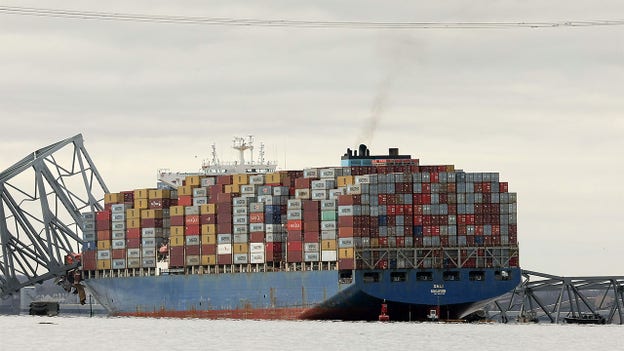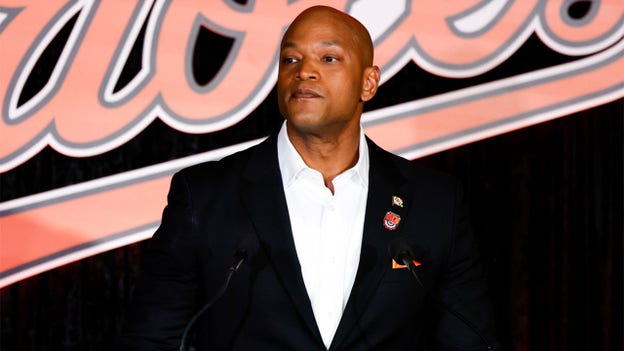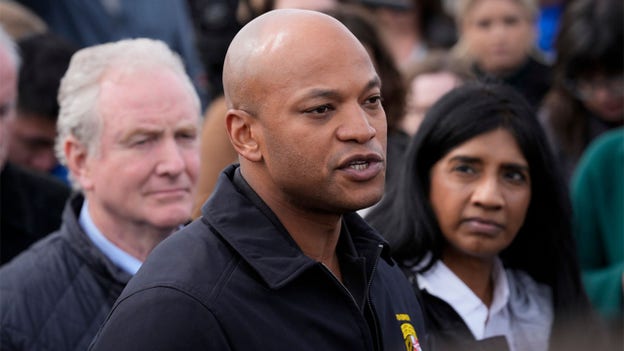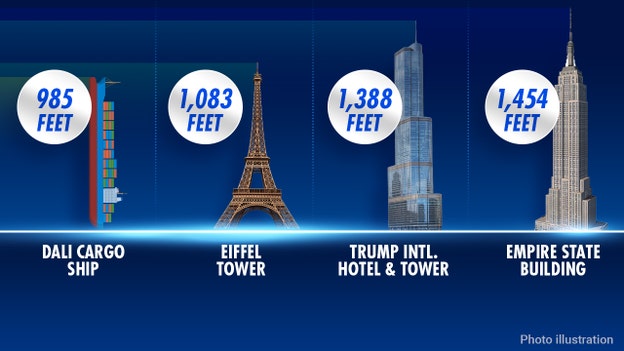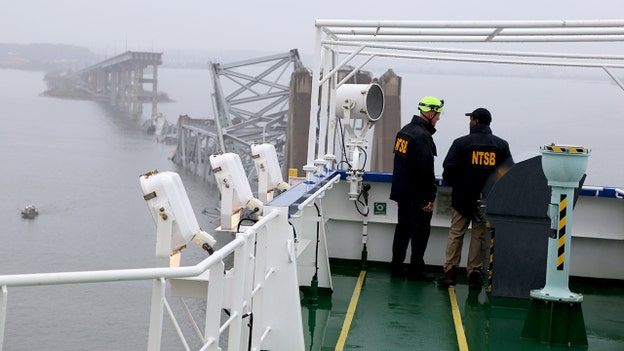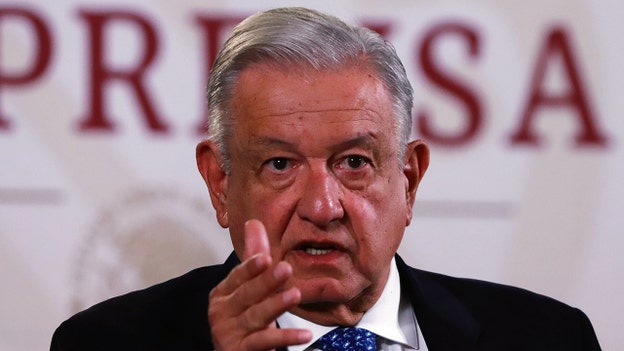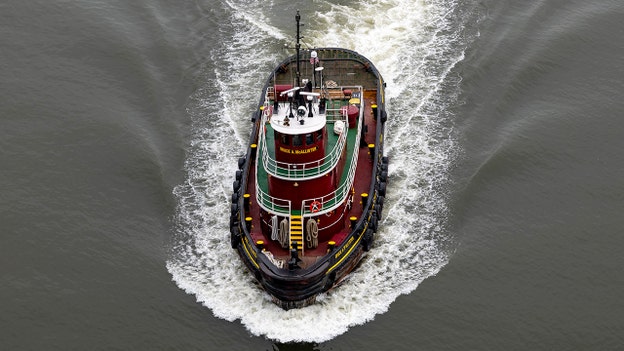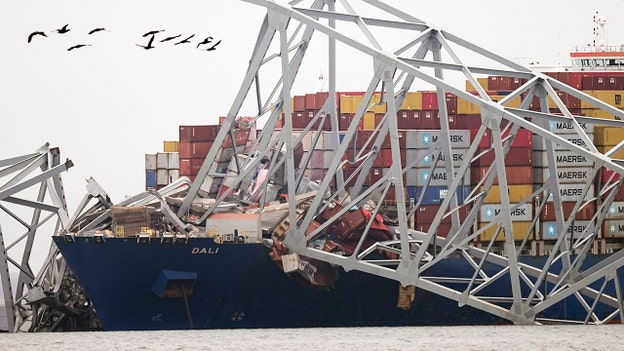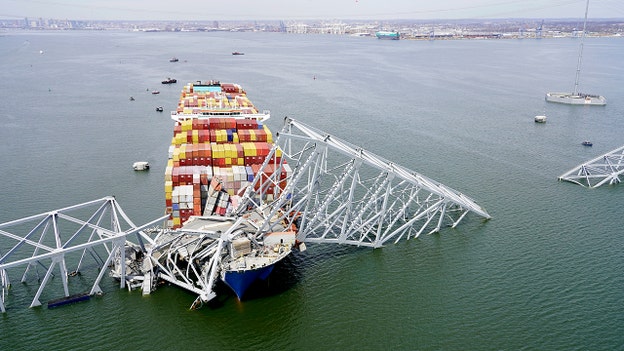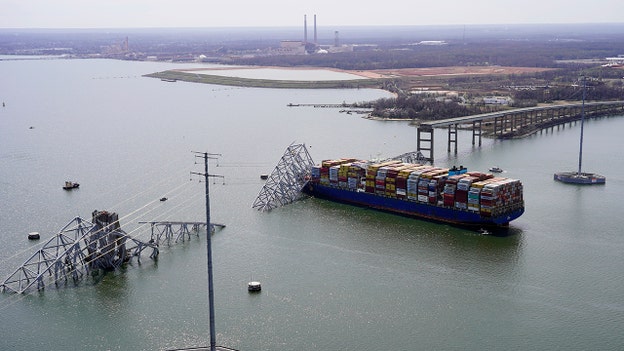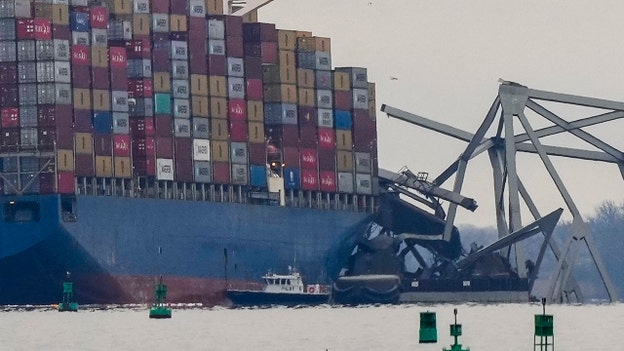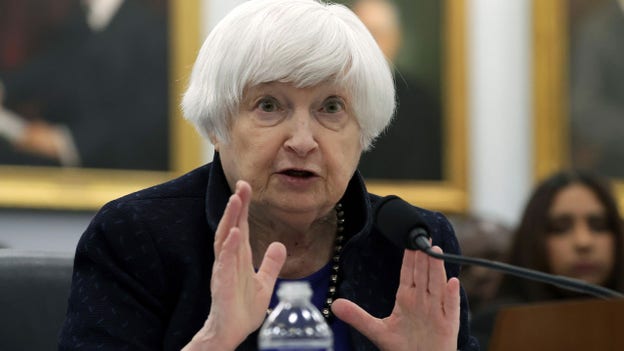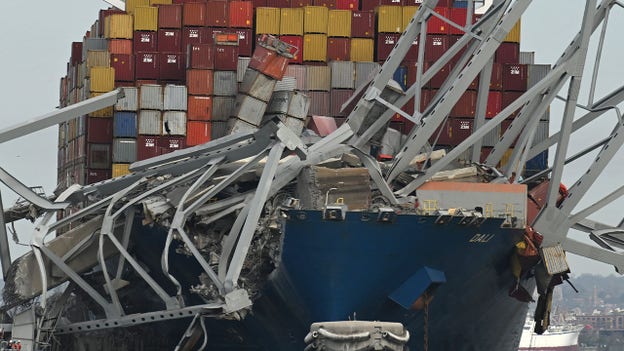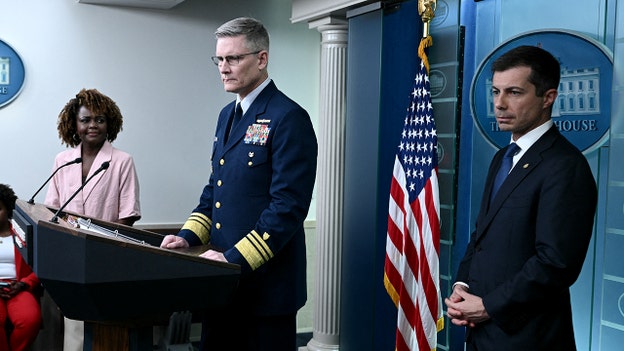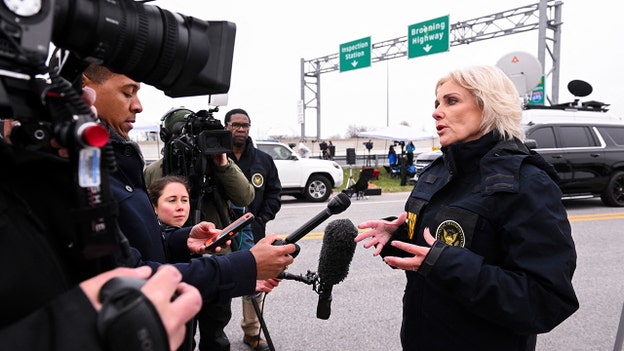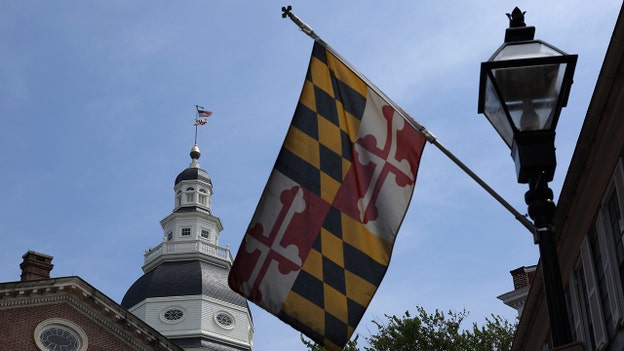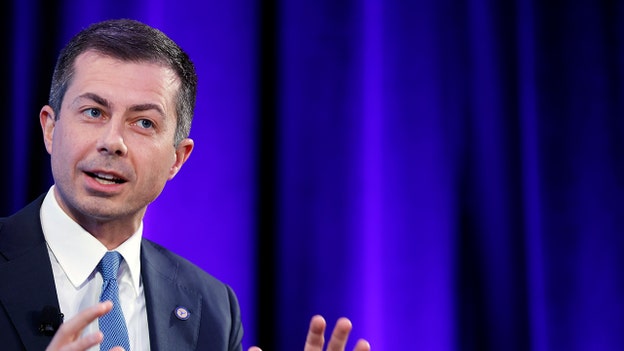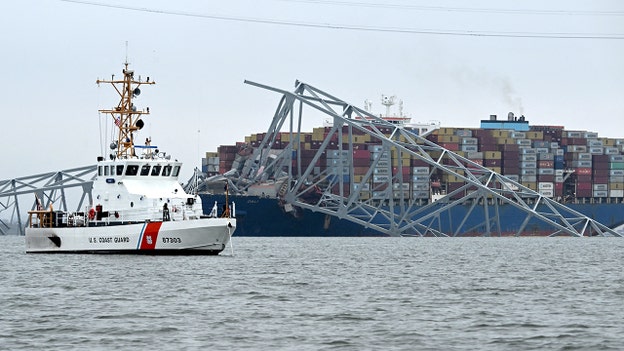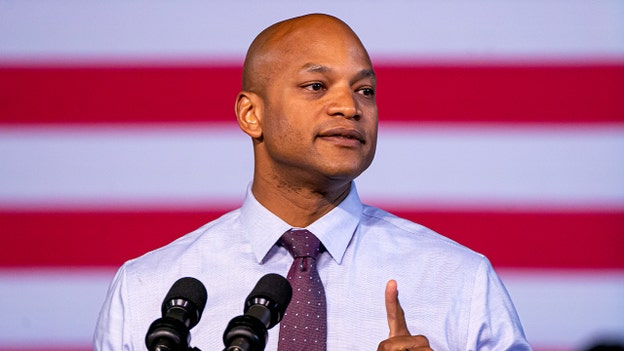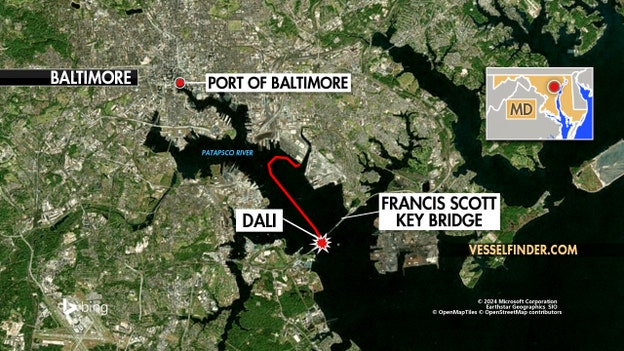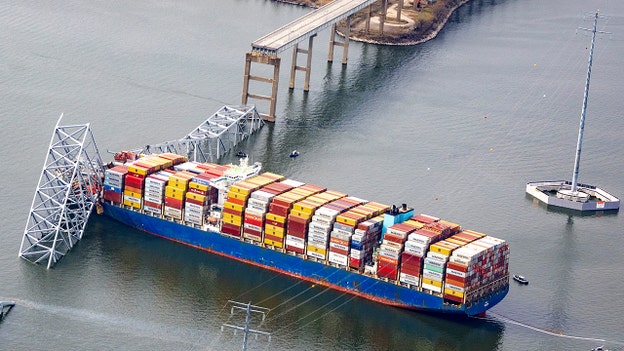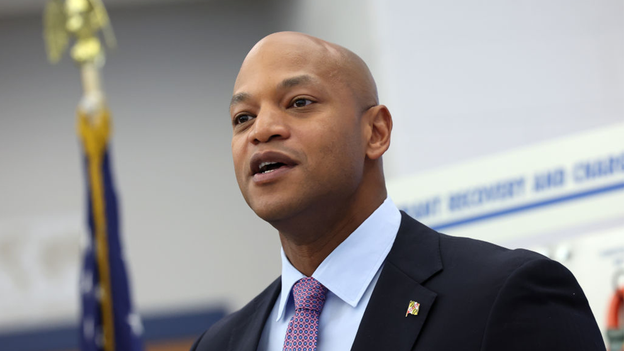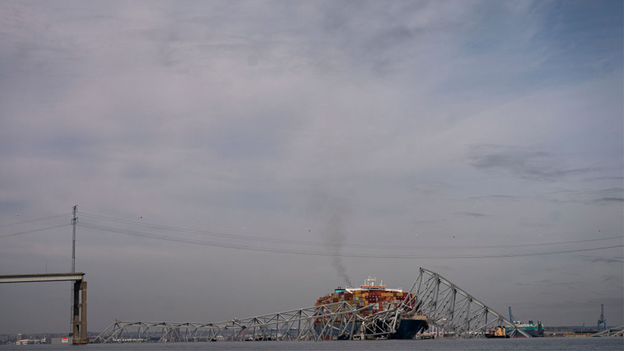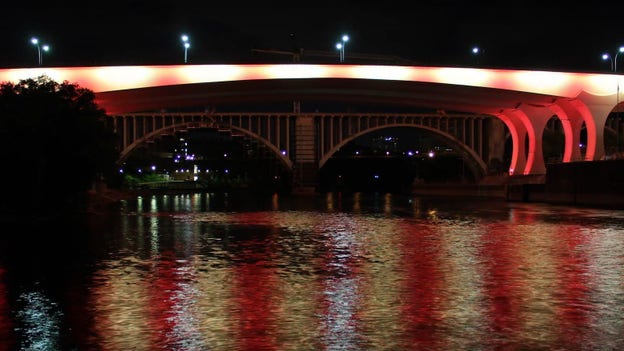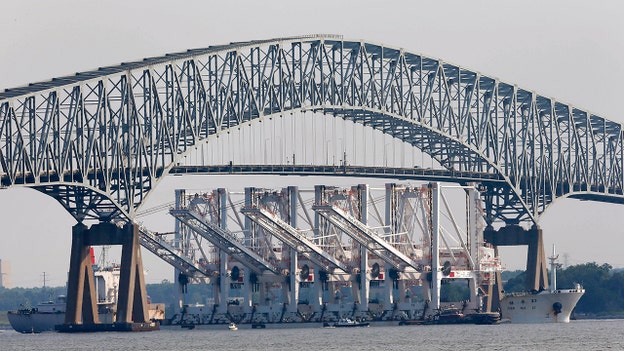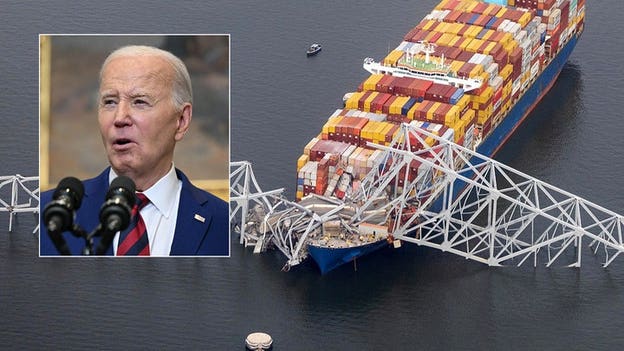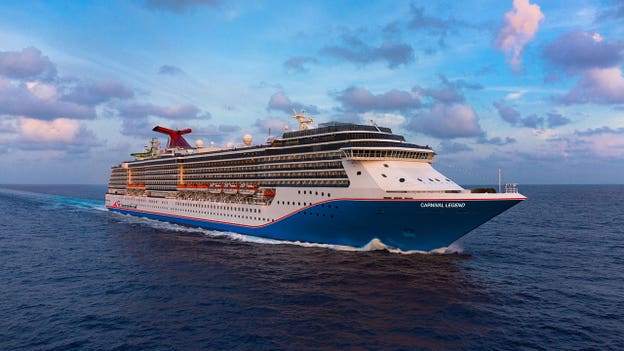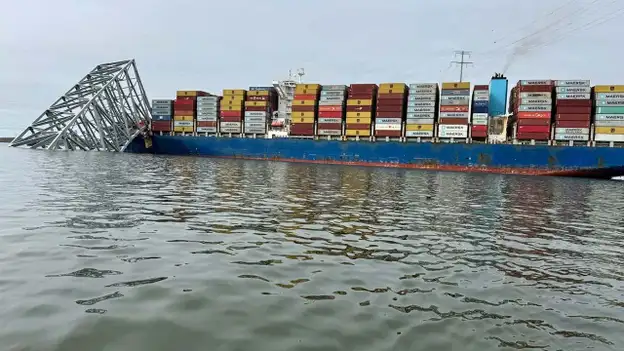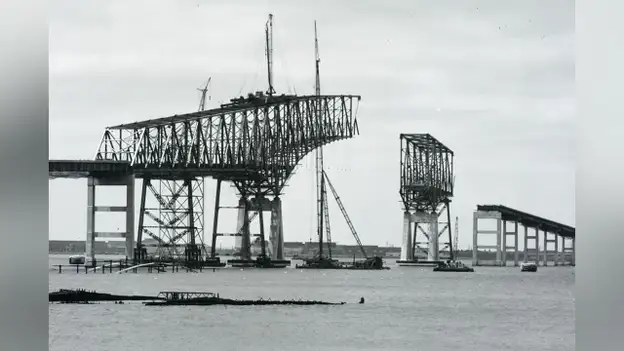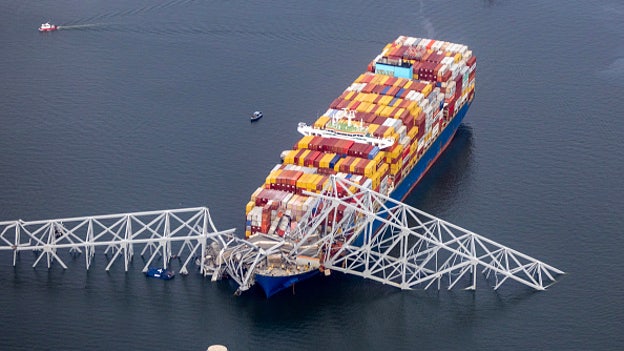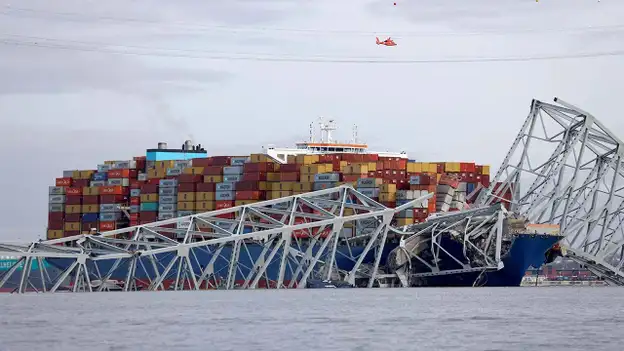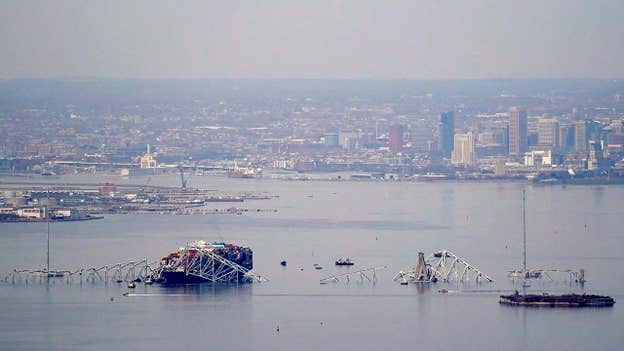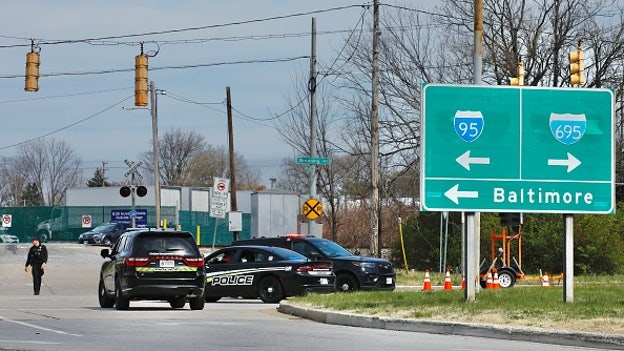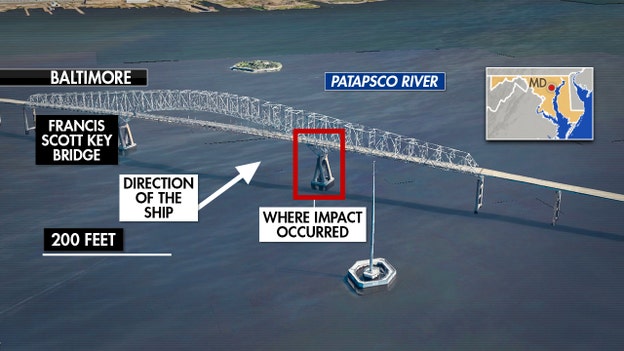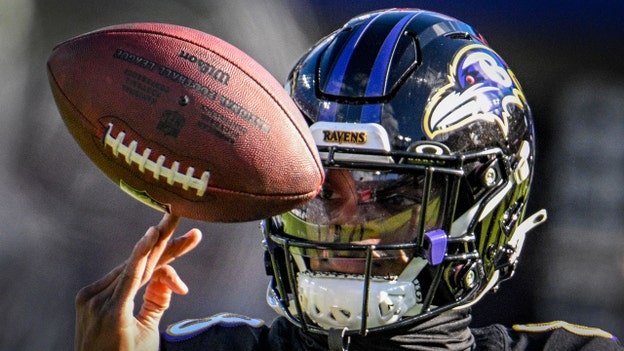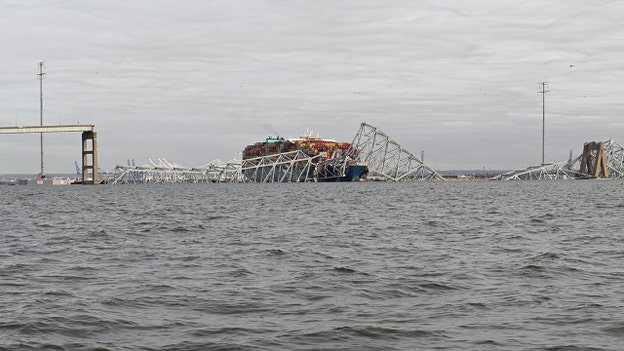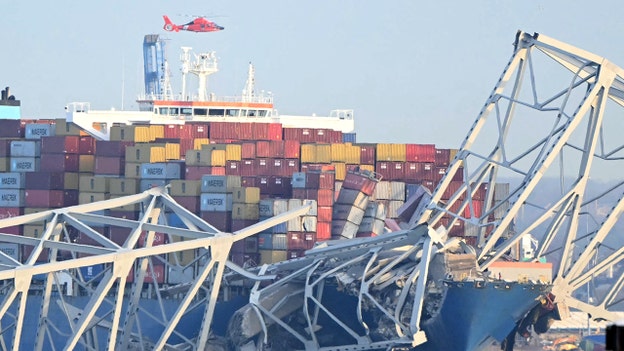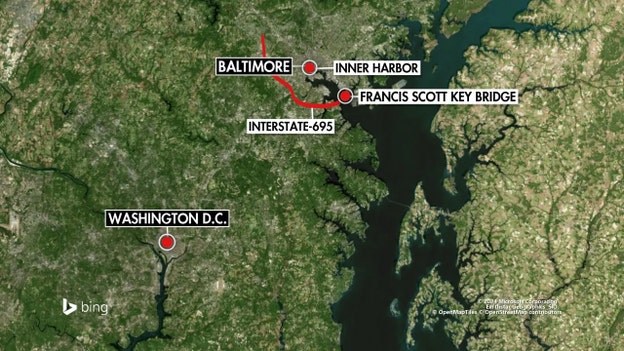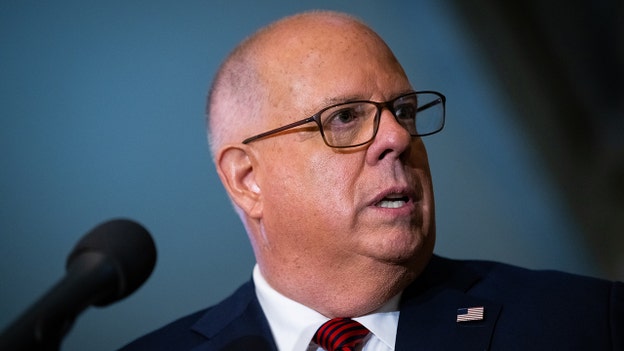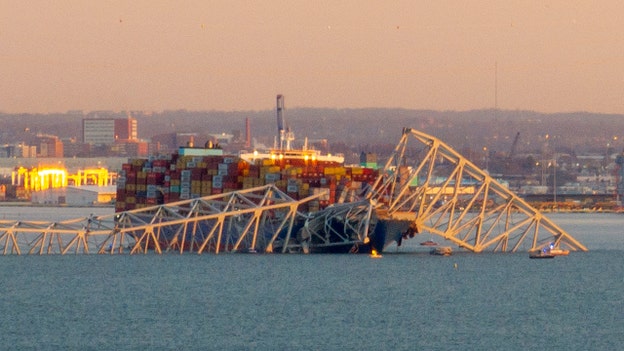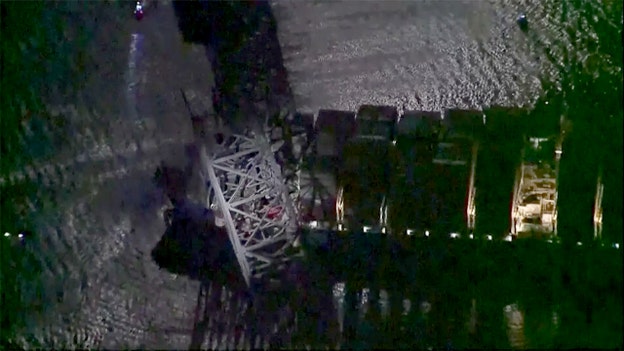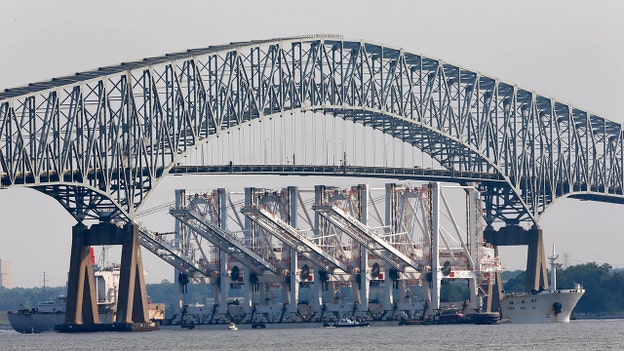Baltimore bridge collapse: two bodies recovered during search for victims
The Francis Scott Key Bridge in Baltimore, Maryland collapsed into the Patapsco River early Tuesday morning, after a cargo ship struck one of its support columns. At least six people are presumed dead after the tragedy.
Coverage for this event has ended.
The Singaporean-flagged cargo ship, the Dali, that caused the Francis Scott Key Bridge to collapse this week was involved in another crash less than a decade ago.
Video obtained by Reuters shows the Dali scraping against a quay in Antwerp, Belgium in 2016. The vessel was built a year earlier.
Per VesselFinder, which tracks ships around the world, an investigation into the 2016 incident determined that the ship’s master and pilot were to blame. There were no injuries or water pollution reported in the incident.
It was unclear what crew were aboard the Dali in the 2016 incident.
As for the Baltimore bridge collapse crash, Synergy Marine Group, which manages the Dali, said the ship’s captain and crew are all Indian. There were two harbors pilots – both U.S. citizens – who were guiding the Dali out of the port at the time of the collision.The U.S. Coast Guard said Wednesday that the ship underwent “routine engine maintenance” in the port before it lost power.
An inspection of the Dali last June at a port in Chile identified a problem with the ship’s “propulsion and auxiliary machinery,” according to Equasis, a shipping information system. The deficiency involved gauges and thermometers, but the website’s online records didn’t elaborate.
A “standard examination” conducted by the U.S. Coast Guard in New York in September didn’t identify any deficiencies, according to the Equasis data.
A former U.S. Army and Marine veteran who spoke with Fox News Digital said Thursday that the Dali cargo ship that struck the Francis Scott Key Bridge, leading to its collapse, was likely suffering electrical issues soon after it left the port.
"For a vessel to have some sort of power outage would imply that there was an electrical systems issue within the ship itself," Jason Nelson said.
Nelson, who was stationed 10 yards from the bridge at Fort McHenry during his final two years in the Army, said the ship could clearly be seen moving in from the southwest and making a starboard, turning toward the bridge and then eventually drifting into the pylon.
This is an excerpt of a story by Bradford Betz. Click here to read the full report.
Maryland Gov. Wes Moore provided an update Thursday evening on recovery efforts in the wake of the collapse of the Francis Scott Key Bridge, saying there was a "long road ahead."
Sharing the podium with Democratic Sens. Ben Cardin and Chris Van Hollen and Baltimore Mayor Brandon Scott, Moore said, "there is nothing that we will not do" to ensure a swift and proper conclusion.
The Democratic governor thanked the Biden administration for greenlighting his request for $60 million in federal aid to jumpstart recovery efforts.
Gov. Moore said it was imperative to clear the channel and open vessel traffic to the port because "the health of the Maryland economy and the national economy depends on it."
This is an excerpt of a story by Bradford Betz. Click here to get the full report.
Before the first pitch at Camden Yards to kick off the 2024 MLB season, the Baltimore Orioles honored the Maryland Transportation Authority for its quick response after the cargo ship crash that destroyed the Francis Scott Key Bridge.
The vessel struck the Baltimore bridge, named after the man who wrote America's national anthem, "The Star-Spangled Banner," March 26.
Two bodies have been recovered during the search for victims after the bridge collapsed.
As Camden Yards waited for the reigning AL East-champion Orioles to take the field, members of the MDTA were saluted as they stood behind home plate. Baltimore Mayor Brandon Scott and Maryland Gov. Wes Moore stood next to them applauding along with the crowd.
Sgt. Paul Pastorek, K9 Unit, a 13-year veteran; Cpl. Jeremy Herbert, Central Command Detachment, a 19-year veteran; and Officer Garry Kirts, Central Command Detachment, a six-year veteran, were saluted in the third inning.
This is an excerpt of a story by Scott Thompson. Click here to read the full report.
The Biden administration on Thursday announced $60 million for emergency aid to help fast-track recovery efforts in the wake of the Francis Scott Key Bridge collapse in Baltimore.
The federal aid will help pay for debris removal and other initial costs. Maryland Gov. Wes Moore’s administration made the request earlier Thursday, as he warned of a “very long road ahead.
The U.S. Department of Transportation’s Federal Highway Administration (FHWA) approved the funds within hours, saying they would serve as a down payment toward initial costs. Additional Emergency Relief program funding will be made available as the work continues.
“No one will ever forget the shocking images of a container vessel striking the Francis Scott Key Bridge, causing its collapse and the tragic loss of six people,” U.S. Transportation Secretary Pete Buttigieg said in a statement.
“The federal emergency funds we’re releasing today will help Maryland begin urgent work, to be followed by further resources as recovery and rebuilding efforts progress. President Biden has been clear: the federal government will do everything it takes to help rebuild the bridge and get the Port of Baltimore back open.”
Former two-term Maryland Gov. Larry Hogan says he's urging fellow Republicans on Capitol Hill to support federal funding to rebuild the collapsed Francis Scott Key Bridge.
"I’m going to push them as hard as I can. I’ve already called a couple of Republican Senate leaders and started working them," Hogan, who's running for a Democratic-controlled open Senate seat in his home state, emphasized in a Fox News Digital interview on Thursday.
Six construction workers were presumed killed when the bridge collapsed on Tuesday moments after a large container ship slammed into a pillar.
President Biden quickly pledged that the federal government would pay the "entire cost" to rebuild the near half-century old structure. Much of the funding will come from the Federal Highway Administration’s emergency fund, which needs to be replenished on an annual basis.
This is an excerpt of a story by Paul Steinhauser. Click here to read the full report.
The Port of Baltimore says federal, state, and local partners are working together to rebuild after the Francis Scott Key Bridge collapsed earlier this week.
The Singaporean-flagged cargo ship, the Dali, slammed into the bridge early Tuesday, leading the entire span to collapse into the Patapsco River.
The collapse is expected to create a logistical nightmare, shutting down ship traffic at the Port of Baltimore and snarling cargo and commuter traffic.
President Biden said he expects the federal government to pick up the entire rebuilding cost. Maryland Gov. Wes Moore on Thursday asked the Biden administration for $60 million to pay for debris recovery and other initial costs.
The administration of Maryland Gov. Wes Moore on Thursday requested $60 million in emergency federal funding to fast-track recovery efforts in the Baltimore bridge collapse.
The Democratic governor said the funding was needed to "lay the foundation for a rapid recovery."
President Biden has signaled the federal government would pay the full cost of rebuilding the bridge, but those comments were undermined by U.S. Treasury Secretary Janet Yellen, who said Wednesday that the recovery would be paid for by insurance payouts.
Maryland Transportation Secretary Paul J. Wiedefeld said the state’s budget for emergencies is “limited and unable to fund an emergency of this magnitude.”
A “quick release” of emergency funds, Wiedefeld said, would allow the state “to proceed expeditiously with debris removal, demolition, traffic operations restoration, and emergency construction to this vital link on the National Highway System in Baltimore, Maryland.”
Gov. Moore has promised that "the best minds in the world" were working on plans to clear the debris, move the cargo ship that rammed into the bridge from the channel, recover the bodies of the four remaining workers presumed dead, and investigate what went wrong.
"Government is working hand in hand with industry to investigate the area, including the wreck, and remove the ship," Moore said.
The U.S. Army Corps of Engineers tells Fox News Digital that it is "too early" to provide an estimate on when the wreckage of the collapsed Francis Scott Key Bridge will be removed from the Patapsco River to allow marine traffic to flow freely into the Port of Baltimore again.
Transportation Secretary Pete Buttigieg says the military branch has been tasked, along with the Coast Guard, to clean up the area as part of a rebuilding process that he warned Wednesday will "not be quick or easy or cheap."
"It is too early to provide timeline estimates on channel clearance and reopening," a U.S. Army Corps of Engineers spokesperson told Fox News Digital. "Our priority remains providing support to the U.S. Coast Guard and our state and local partners’ recovery efforts at this time."
The Army Corps of Engineers says its Baltimore District has activated its emergency operations center, which clears the way for "more than 1,100 engineering, construction, contracting and operations specialists to provide support to local, state and federal agencies" responding to Tuesday’s bridge collapse.
The branch says it will provide underwater assessment capabilities, structural engineering support – including "certified bridge safety inspectors and urban search and rescue structural technical specialists" – and removal of debris in the waterway that could pose threats to navigation.
The massive container ship that struck and collapsed the Francis Scott Key Bridge in Baltimore on Tuesday would be roughly the size of the Eiffel Tower if stood upright.
The Singapore-flagged Dali is also about two-thirds the size of the Empire State Building. It can carry the equivalent of almost 10,000 standard-sized metal shipping containers, and at the time of the accident was carrying nearly 4,700 containers, the Associated Press reported.
Even so, the Dali is dwarfed by the world's largest container ships, which can transport more than 24,000 containers. There are environmental and economic advantages to operating giant container ships, but their sheer size and weight make them difficult to maneuver and stop — especially when something goes wrong.
The Dali measures 984 feet long and weighs approximately 95,000 tons when empty. It's total capacity is 10,000 20-foot containers.
Experts have suggested Baltimore's Key Bridge was not designed to handle the force of an impact from modern shipping vessels, which would explain its shocking collapse.
The Associated Press contributed to this update.
Scott Redler, the chief strategist for T3 Trading Group, joined "Cavuto: Coast to Coast" on Wednesday to discuss how Black Swan events like the Baltimore bridge collapse impact markets.
Redler said that the Francis Scott Key Bridge disaster has not affected markets in the way some might expect following an emotional tragedy.
"What you want to do is you want to see the reaction to an event that you didn't think could happen, or a black swan or, just out of the blue, and what the market does is it trades and it lets you know, potentially, does it mean something or not mean something," he told host Neil Cavuto.
Some unforeseen events, like the war between Russia and Ukraine or the Oct. 7 surprise attack on Israel create temporary market volatility, based on material changes or even emotions, Redler explained.
"It's up to the market participant to know their timeframe on whether or not they need to change their investment strategy or if there are ways to — I hate to say it, unfortunately, to make some money from the misallocations of that day's over-emotion. And as traders, that's what we look for, to see if there's over-emotion.
"The Baltimore event, as tragic as it is, the market kind of ignored it."
The recent collapse of the Francis Scott Key Bridge in Maryland has brought attention to other past instances of bridge incidents stemming from vessel hits.
The Key Bridge, which crossed the Patapsco River near Baltimore, sustained a hit from a large container ship early Tuesday morning, causing it to collapse. The incident left six missing people presumed dead and is expected to impact the economy.
Past examples of bridge collapses include the Sunshine Skyway Bridge, Interstate 40 bridge, and the Big Bayo Canot.
The original Sunshine Skyway Bridge experienced a partial collapse that took the lives of nearly three dozen people over 43 years ago. Their ages reportedly ranged from 7 months old to 92 years old.
That incident occurred after a massive ship ran into part of the bridge that goes over Florida’s Tampa Bay during a severe storm, according to the Tampa Bay Times.
Another incident is the 2002 collapse of the Interstate 40 bridge near Webbers Falls, Oklahoma.
In a report, the National Transportation Safety Board (NTSB) linked the collapse to a towboat that "veered off course and rammed" into the bridge. The roughly 100-foot towboat had been maneuvering a pair of barges.
The collapse, which caused 14 deaths, affected about 500 feet of the bridge. Nearly 60 local, state and federal agencies were involved in responding to the incident.
The Big Bayou Canot bridge incident caused the deaths of 47 people. It took place in 1993.
All of those individuals had been traveling on an Amtrak train that partially fell into the water from the bridge near Mobile, Alabama, according to The Associated Press.
The railroad bridge became misaligned due to a hit from barges being transported by a towboat called Mauvilla. Fog and other factors contributed to the collision, according to an NTSB report published online by Wikimedia.
Multiple train cars, including two for passengers and ones for baggage and sleeping, derailed in the incident, the report said. It has been called one of Amtrak’s worst-ever rail accidents in terms of fatalities, according to the AP.
FOX Business' Aislinn Murphy contributed to this update.
The National Transportation Safety Board (NTSB) released several photos from its investigation aboard the cargo vessel Dali, which struck and collapsed the Francis Scott Key Bridge in Baltimore on Tuesday.
The images show investigators surveying damage to the ship and launching a drone. Several NTSB officials are pictured viewing the collapsed bridge from different angles on the cargo ship.
At a press conference Wednesday, NTSB chair Jennifer Homendy said the Singaporean-flagged cargo ship had been carrying 56 containers of hazardous materials on board, including corrosive flammable cells, lithium ion batteries, and other hazardous materials.
Some of the hazmat containers were breached, and a sheen was identified in the water that will be dealt with by the authorities.
Homendy said the voyage data recorder (VDR) has been recovered. NTSB investigator Marcel Muise said the VDR contains information from midnight to approximately 6 a.m.
Homendy said the investigation would be a “massive undertaking” that is expected to take one to two years. She added that the NTSB will not hesitate to issue urgent safety recommendations during that time frame. A preliminary report is expected in only two to four weeks.
Fox News Digital's Bradford Betz contributed to this update.
When the cargo ship Dali lost power and propulsion as it headed out of Baltimore Harbor, the pilot issued several commands in an attempt to stop the vessel before it hit Francis Scott Key Bridge.
Audio recordings collected from the ship's Voyage Data Recorder showed the pilot was heard calling for tugboat assistance several minutes before the crash. He also ordered the crew to drop anchor and pull the rudder, according to NTSB investigators.
Safety board investigator Marcel Muise said data showed the Dali, measuring about three football fields in length and piled high with shipping containers, was moving at about 8 miles per hour when it struck a bridge abutment.
Clay Diamond, executive director of the American Pilots Association, told CNN the Dali pilot took all appropriate steps once he lost control of the ship, "but it happened so quickly and with so little lead time, neither one of those maneuvers were enough."
The ship was too large and too close to prevent the collision that destroyed the bridge.
Reuters contributed to this update.
Mexico President Andrés Manuel López Obrador says the collapse of the Francis Scott Key Bridge in Baltimore shows that "migrants go out and do risky jobs at midnight" and as a result they "do not deserve to be treated as they are by certain insensitive, irresponsible politicians in the United States."
López Obrador made the remark as Maryland State Police identified one of the two bodies removed from the Patapsco River on Wednesday as 35-year-old Alejandro Hernández Fuentes, originally from Mexico.
"Based upon the conditions, we're now moving from a recovery mode to a salvage operation because of the superstructure surrounding what we believe are the vehicles and the amount of concrete and debris; divers are no longer able to safely navigate or operate around that in the areas around this wreckage," Col. Roland L. Butler Jr., superintendent of Maryland State Police, said during a press conference Wednesday night.
Guatemalan Dorlian Ronial Castillo Cabrera, 26, was identified by Butler as the other body removed from the water. Divers had found a red pickup truck submerged under approximately 25 feet of water in the middle span of the bridge and discovered the two bodies trapped inside.
Four other construction workers are presumed dead following Tuesday’s disaster, in which the cargo ship Dali slammed into one of the bridge’s pillars in the early morning hours, causing the span to collapse. They are also from Guatemala and El Salvador.
Another victim has been identified as 38-year-old Maynor Yassir Suazo Sandoval, who was the youngest of eight siblings from Azacualpa, a rural mountainous area in northwestern Honduras, according to The Associated Press.
Moments before the Singapore cargo ship Dali crashed into the Francis Scott Key Bridge, a pilot made a radio call for tugboats.
Tugboats are small ships that assist larger vessels by pushing or pulling them with direct contact or a tow line. Their purpose is to guide ships into and out of harbors to prevent accidents like the Baltimore bridge collapse.
So why didn't tugboats help on Tuesday, when the Dali struck a support pier on the Key Bridge, causing it to fall into the Patapsco River?
Cargo ships entering and exiting the Baltimore harbor are guided by tugboats that flank the ship on each side while a Chesapeake Bay pilot on board assist the ship's bridge and captain with navigational commands, according to the Baltimore Banner.
"Ship tracking data from marinetraffic.com showed the Dali was headed toward the Key Bridge unaccompanied when it crashed into the bridge early Tuesday morning," the paper reported.
"Two tugboats, both operated by McAllister Towing and Transportation, helped the Dali out of the dock between 12:30 a.m. and 1 a.m. Those tugboats left the cargo ship around 1:09 a.m. The Dali begins veering right and away from the main channel at 1:25 a.m., four minutes and 23 seconds before it struck the bridge."
Those tugboats, the Eric McAllister and Bridget McAllister, were then the first to respond after the Dali crashed into the bridge, ship tracking data showed, according to the Baltimore Banner.
It is common practice for tugboats to break away before the bridge. But on Tuesday, the Dali lost power and propulsion shortly after they did so, and by then it was too late to stop the accident.
Carnival Corporation said Wednesday the Francis Scott Key Bridge collapse in Maryland could have a negative effect on its full-year earnings.
The cruise line operator told shareholders it could see a "current estimated impact of up to $10 million on both adjusted EBITDA [earnings before interest, taxes, depreciation and amortization] and adjusted net income for the full year 2024."
The bridge fell into the Patapsco River near Baltimore early Tuesday morning. Its collapse stemmed from a large container ship striking one of its support columns.
The nearby Port of Baltimore has experienced some disruptions due to the Francis Scott Key Bridge incident, halting vessel traffic "until further notice" though it said Tuesday. "Trucks are being processed within our marine terminals" still.
Carnival, which sails out of the Baltimore port for certain cruises, said it did not incorporate the $10 million estimated impact in its 2024 outlook "given the timing of yesterday’s event in Baltimore and the temporary change in homeport." It also reported seeing "record" first quarter revenues of $5.4 billion and a smaller net loss of $214 million.
Just a day earlier, the company temporarily switched the homeport of its Carnival Legend ship to Norfolk, Virginia, amid the ongoing situation in Baltimore.
"Fortunately, our teams quickly secured a temporary homeport in Norfolk for as long as it's needed, which should help to minimize operational changes," CEO Josh Weinstein told analysts and investors on Tuesday. "We look forward to getting back to our home in Baltimore as soon as possible."
FOX Business' Aislinn Murphy contributed to this update.
It didn't take long for The Washington Post to revisit the history of "controversial poet" Francis Scott Key, whose namesake bridge suffered a devastating collapse in Baltimore.
All eyes were on Charm City early Tuesday morning after a cargo ship crashed into a support beam of the Francis Scott Key Bridge. Six construction workers who were on the bridge at the time are presumed dead and two were rescued from the Patapsco River. An investigation is underway.
But roughly 24 hours later, The Post insisted Key himself was "at the center of renewed public attention" because the bridge named after him collapsed.
"The incident has shaken Baltimore and brought Key once again to the fore," The Post wrote Wednesday.
The Post offered a biographical history lesson of Key, a lawyer famous for writing what's now known as "The Star-Spangled Banner."
But as the paper noted in its previous report about Key published in 2020 following the George Floyd riots, there was an "ugly reason" why the iconic poem wasn't chosen as the national anthem for more than 100 years.
"'The Star-Spangled Banner' did not become the national anthem until more than a century after it was written because of controversy, partly over Key’s racist views," The Post wrote. "One section of the poem’s third verse, in particular, has come under scrutiny from those who say it was intended to mock or threaten African Americans who escaped slavery to join the British forces, after being promised land in exchange for their service."
The article then printed what Key had written in the third verse, which read, "No refuge could save the hireling and slave, From the terror of flight or the gloom of the grave, And The Star-Spangled Banner in triumph doth wave, O’er the land of the free and the home of the brave."
Fox News Digital's Joseph A. Wulfsohn contributed to this update.
The collapse of the Francis Scott Key Bridge in Baltimore, Maryland on Tuesday raised serious questions about what safety or protective mechanisms could have been in place to prevent such a disaster.
It is still unclear what caused a massive 985-foot long cargo vessel to apparently lose control and strike the supportive pylon, a critical part of the structure that keeps the deck of the bridge in place.
Could the bridge have been better protected to safeguard against a large vessel striking a key part of its infrastructure? Experts say the answer is not so simple.
Ron Harichandran, Ph.D., dean of the Tagliatela College of Engineering in Connecticut, told Fox News Digital that protective barriers – if they were there – may not have been enough to stop the Dali, given its sheer size and weight. The Singapore-flagged container has dead weight tonnage, or total tonnage, of nearly 117,000 tons.
"Most of those protections systems that they have directly around the pier would probably not have been able to protect this particular incident because of the size of the cargo ship and the weight," Harichandran said. "It was just too big."
"The only thing that might have worked is if they had sort of an island around the piers and that's not done often," Harichandran added. "It basically involves filling up an area of the river and building an island, so the ship would hit the island and not the pier. That's what you would have to do if you wanted that level of protection, but obviously, that's quite expensive."
"It should really have been done at the time the bridge is built and not retrofitting it," he added.
Jennifer Homendy, the chair of the National Transportation Safety Board, said at a Tuesday press briefing that protective structures would be a part of the investigation into the collapse of the Maryland bridge.
"There’s some questions about the structure of the bridge – protective structure around the bridge or around the piers to make sure there isn’t a collapse," she said, responding to a reporter’s question. "We are aware of what a structure should have. Part of our investigation will be how was this bridge constructed? It will look at the structure itself. Should there be any sort of safety improvements? All of that will be part of our investigation."
The Francis Scott Key Bridge, which was built in 1977, does not appear to have any protective barriers in place, and the pier that was struck was not surrounded by any barrier or buffer-like structures, according to photos and videos from the scene.
There are some small circular-shaped structures in the water, but it is unclear if they are barriers that serve another purpose. A spokesperson for the National Transportation Safety Board (NTSB) did not respond to Fox News Digital's request for comment about whether the Baltimore bridge had a bumper system or protective barriers in place.
Fox News' Michael Dorgan contributed to this report.
The governments of Mexico, Guatemala, El Salvador and Honduras have confirmed that their nationals are among those killed or still missing after a cargo ship slammed into the Francis Scott Key Bridge early Tuesday, causing it to fall into the Patapsco River.
At least eight people fell into the water and two were rescued. Two bodies were recovered Wednesday and four remain missing. They are presumed dead.
Guatemala’s Foreign Affairs Ministry had earlier confirmed that two of its citizens were among the missing.
And El Salvador's foreign minister, Alexandra Hill Tinoco, posted Wednesday on X that one Salvadoran citizen, Miguel Luna, was among the missing workers.
In Mexico, President Andrés Manuel López Obrador said three Mexicans were on the bridge when it fell, including one who was injured but rescued and two who were still missing.
López Obrador did not disclose their names for privacy reasons.
According to the Mexican president, the migrants took on the risky job at midnight to highlight their dedication to finding employment in the U.S. to help boost its economy.
“This demonstrates that migrants go out and do risky jobs at midnight. And for this reason, they do not deserve to be treated as they are by certain insensitive, irresponsible politicians in the United States,” López Obrador said.
Later, Col. Roland L. Butler Jr., superintendent of Maryland State Police, announced that the bodies of two men, ages 35 and 26, had been located by divers inside a red pickup submerged in about 25 feet (7.6 meters) of water near the bridge’s middle span.
They were identified as Guatemalan Dorlian Ronial Castillo Cabrera, 26, and 35-year-old Alejandro Hernández Fuentes, originally from Mexico.
The victims include an enterprising Honduran father and husband, according to his family.
Maynor Yassir Suazo Sandoval, 38, was confirmed to be among those presumed to be dead. He was from Azacualpa, a rural mountainous area in northwestern Honduras along the border with Guatemala. He is survived by a wife and two children ages 17 and 5.
Federal and state investigators said Tuesday’s crash appears to have been an accident.
The Associated Press contributed to this report.
The Maryland Transportation Authority Police released harrowing dispatch audio from moments before the container ship Dali rammed into the Francis Scott Key Bridge in the Baltimore Harbor.
At approximately 1:25 a.m. on Tuesday, the Dali veered off course, lost power and struck one of the iconic bridge's support pillars.
"I need one of you guys on the south side, one of you guys on the north side, hold all traffic on the Key Bridge," an officer can be heard saying in the released audio.
The officer added: "There's a ship approaching that just lost their steering so until we get that under control, we've got to stop all traffic.”
Just four minutes later, another officer can be heard saying in the police dispatch audio that the bridge had fallen.
"The whole bridge just fell down! Start whoever, everybody — the whole bridge just collapsed!" the officer said.
Fox News Digital's Chris Pandolfo and Greg Norman contributed to this update.
The Baltimore bridge collapse that left six people dead on Tuesday is the latest deadly collapse across the United States prompted by a sea vessel or ship strike.
On May 26, 2002, the Interstate 40 bridge spanning the Arkansas River at Webbers Falls, Oklahoma, collapsed after it was struck. A 500-foot section fell after the barge struck it, sending multiple vehicle plunging into the water.
The incident left 14 people dead. Another 11 people were injured.
On Sept. 15, 2001, the Queen Isabella Causeway collapsed in Port Isabel, Texas, leaving eight people dead. The incident was prompted by a tugboat and a barge, which struck the bridge, causing a midsection of the bridge to tumble 80 feet into the bay below.
On Sept. 22, 1993, the Big Bayou Canot railroad bridge near Mobile, Alabama collapsed after barges being pushed by a towboat in dense fog struck the bridge. Minutes later, an Amtrak train with 220 people aboard reached the bridge and derailed, leaving 47 people dead and injuring 103 people.
Another major collapse happened on May 9, 1980, when the Summit Venture vessel was navigating through the narrow, winding shipping channel of Florida’s Tampa Bay. After the ship’s radar was knocked out, the 609-foot freighter hit a support of the Sunshine Skyway Bridge, causing a 1,400-foot section of concrete roadway to fall.
The collapse caused six vehicles and a bus with 26 aboard to fall 150 feet into the water. Thirty-five people died.
Other non-fatal, major collapses include the Popp’s Ferry Bridge in Biloxi, Mississippi on March 20, 2009; and, the Eads Bridge collapse on the Mississippi River, near the St. Louis Harbor, on April 14, 1998, left 50 injured.
According to the World Association for Waterborne Transport Infrastructure, there have been 35 major bridge collapses worldwide due to ship or barge collisions from 1960 to 2015.
The Associated Press contributed to this report.
The Singaporean-flagged Dali ship that crashed into the Francis Scott Key Bridge in Baltimore early Tuesday morning underwent “routine engine maintenance” in port before the crash, an official with the U.S. Coast Guard said Wednesday.
U.S. Coast Guard Rear Admiral Shannon Gilreath said at a news conference that authorities were informed that the ship was going to undergo the maintenance but said there were no known issues with the ship's engine.
“As far as the engine goes, we were not informed of any problems with the vessel,” he said.
The Dali left port at 12:39 a.m. on Tuesday and entered the waterway. It then began experiencing signs of trouble and sounded numerous alarms at approximately 1:25 a.m., according to the NTSB. Just after 1:27 a.m., the pilot commanded the ship to drop an anchor and within two minutes, the vessel collided with the bridge.
According to inspection records, the vessel was also flagged for two deficiencies between 2015 and 2023.
Equasis reported that the Dali had 27 recorded inspections from April 20, 2015 and Sept. 13, 2023, during which time there were two deficiencies found.
On Nov. 27, 2016, the records show the ship was flagged for “hull damage impairing seaworthiness,” in Antwerp, Belgium.
Then on June 27, 2023, the ship was flagged for an issue categorized under propulsion and auxiliary machinery, and sub categorized as “gauges, thermometers, etc.”
Its most recent inspection was conducted by the U.S. Coast Guard in New York on Sept. 13, 2023, when no deficiencies were reported.
The Associated Press contributed to this report.
The black box aboard the Dali, the Singaporean-flagged cargo ship that crashed into a support beam of the Francis Scott Key Bridge, causing it to collapse, is key to figuring out what was going on with the ship’s engine moments before the crash, a maritime expert said.
“That black box would be the vessel data recorder,” Sal Mercogliano, a former merchant mariner, said on "Your World with Neil Cavuto." “So it would have all the readings from the engine room, everything that potentially led to the loss of power on the vessel.”
He added: “It would also have all the instrumentation from the bridge. And probably most interesting for everybody is a voice recorder that records the conversations on the bridge, that conversation between the ship's pilots that were on board, helping to navigate the vessel and the ship's master.”
Investigators with the National Transportation Safety Board recovered the black box on Wednesday.
Mercogliano said the ship suffered electrical system failure but that was not the reason its anchor failed to stop it from hitting the support structure.
“Fortunately, the anchors, their brakes, do not require power,” he said. “So you just have to release them. But you have to think about the moment when they wanted to release it. A ship at eight knots, about ten miles an hour, 115,000 tons. An anchor is going to have a hard time stopping it. And it really is not like in the movies where you see that.”
The National Transportation Safety Board (NTSB) held a press conference Wednesday evening to provide an update on the collapse of Baltimore’s Francis Scott Key Bridge.
NTSB chair Jennifer Homendy said the Singaporean-flagged cargo ship, the Dali, had been carrying 56 containers of hazardous materials on board, including corrosive flammable cells, lithium ion batteries, and other hazardous materials.
Some of the hazmat containers were breached, and a sheen was identified in the water that will be dealt with by the authorities.
Homendy said the voyage data recorder (VDR) has been recovered. NTSB investigator Marcel Muise said the VDR contains information from midnight to approximately 6 a.m.
Homendy said the investigation would be a “massive undertaking” that is expected two take one to two years. She added that the NTSB will not hesitate to issue urgent safety recommendations during that time frame. A preliminary report is expected in only two to four weeks.
Part of the investigation will be determining what caused the ship to lose power before hitting the bridge. The source of that outage remained unknown as of Wednesday, Homendy said.
Homendy said tugboats were called to help the vessel leave the port and get to the main channel. The vessel does not have any tugboats at this time. Homendy confirmed that vessel did not have any tugboats helping it navigate through the waters before it hit the bridge. The VDR showed that the pilot called for tugboats just before 1:30 a.m. after the vessel hit the bridge.
The NTSB has confirmed that there were 21 crewmembers on board the vessel at the time of the accident plus two pilots.
Maryland authorities said Wednesday that two bodies have been recovered after a cargo ship slammed into the Francis Scott Key Bridge on Tuesday morning.
Maryland State Police Superintendent Roland Butler identified the victims as Alejandro Hernandez Fuentes, 35, of Baltimore and Dorlian Castillo Cabrera, 26, of Dundalk.
Divers found the victims inside a red pickup truck submerged under approximately 25 feet water in the middle span of the bridge.
Butler said the men's families have been notified by authorities.
"Based upon the conditions, we're now moving from a recovery mode to a salvage operation because of the superstructure surrounding what we believe are the vehicles and the amount of concrete and debris, divers are no longer able to safely navigate or operate around that in the areas around this wreckage," Butler said.
“The collapse of the Key Bridge is not just a Maryland crisis. The collapse of a key bridge is a global crisis. The national economy and the world's economy depends on the port of Baltimore,” Gov. Wes Moore said. “The port handles more cars and more farm equipment than any other port in the country.”
Guatemalan President Bernardo Arévalo has instructed the Guatemalan consulate in Maryland to provide updates on the search for the construction workers who went missing in the Francis Scott Key Bridge collapse early Tuesday.
At least two Guatemalan citizens are among those missing. The others are from Honduras and Mexico, according to diplomats from those countries.
President Arévalo asked the consulate “accompany the family [of those missing] in the necessary procedures.”
“In these difficult times, my solidarity and attention are with them and their families,” he said.
Investigators were constructing evidence Wednesday from the cargo ship that slammed into the bridge, causing it to collapse. Down in the waters below divers were searching through the twisted metal for six construction workers who plunged into the harbor and were feared dead.
An obscure 19th century law could potentially limit the liability for the owner of the cargo ship that slammed into the Francis Scott Key Bridge Tuesday morning, sending the structure, along with workers and vehicles, into the water below.
The 1851 law, if enacted, could save Grace Ocean, the Singapore-based owner of the container ship, hundreds of millions of dollars.
Tulane University’s Maritime Law Centre director Martin Davis told The Straits Times that the law could lower Grace Ocean’s legal woes to only tens of millions of dollars.
The law was originally implemented to help shipping giants avoid devastating losses from disasters while out at sea. The law was cited in a Supreme Court case involving the Titanic more than a century ago.
U.S. Treasury Secretary Janet Yellen on Wednesday appeared to walk back comments from President Joe Biden that U.S. taxpayers would foot the bill for the Francis Scott Key Bridge collapse.
Appearing on MSNBC Wednesday, Yellen said money from the bipartisan infrastructure law that could “potentially be helpful.”
“My expectation would be that ultimately there’ll be insurance payments, in part, to cover this. But we don’t want to allow worrying about where the financing will come from to hold up reconstruction,” Yellen said.
Her comments come a day after Biden said it was his “intention that the federal government will pay for the entire cost of reconstructing that bridge, and I expect the Congress to support my effort.”
Biden said that, while the effort will take some time, the people of Baltimore “can count on us.”
Singaporean officials say they will conduct their own investigation into the Francis Scott Key Bridge collapse in addition to supporting U.S. authorities.
The ship that struck the bridge, the Dali, had been traveling under a Singaporean flag. The Maritime and Port Authority of Singapore said Wednesday it was working with the ship's management company, Synergy Marine Group, to get information to the U.S. Coast Guard for its investigation.
The agency also said Singapore's Transport Safety Investigation Bureau will independently investigate, not to determine liability, but to identify lessons for the future.
The Singapore-flagged cargo ship that struck the Francis Scott Key Bridge, causing its collapse, was transporting containers with hazardous materials, the U.S. Coast Guard said.
Vice Admiral Peter Gautier said during the White House press briefing that of the 4700 containers on board the Dali, 56 contain hazardous materials and two are missing overboard. The ones that are in the water do not contain hazardous materials, he told reporters.
"There is no threat to the public from the hazardous materials on board," Gautier said.
A specialized hazmat team went aboard the ship to inspect the cargo.
“The majority of those containers are closer to the pilot house and are completely unaffected by the damage to the bow of the ship,” he said. “And we have not determined that there's any kind of release at this time.”
“The real critical thing here is that, as you know, a portion of the bridge remains on the bow on that ship, and we will be coordinating very closely with the Army Corps of Engineers and their contractors to first effect the removal of that debris before the vessel can then be removed,” Gautier added. “The vessel bow is sitting on the bottom because of the weight of that bridge debris on there.”
The Coast Guard will be working with the Army Corps of Engineers to lead the cleanup of the Patapsco River so the Port of Baltimore can get back to full operation, Transportation Secretary Pete Buttigieg told reporters.
Fox News Digital's Greg Norman contributed to this update.
U.S. Transportation Secretary Pete Buttigieg delivered an update on the Baltimore bridge collapse recovery effort at Wednesday's White House press briefing.
The secretary outlined the steps the Department of Transportation is taking to reopen the Port of Baltimore, deal with supply chain issues until the port reopens, rebuild the bridge and handle transportation reroutes until the bridge is restored.
"Rebuilding will not be quick, or easy or cheap. But we will get it done," Buttigieg said.
The U.S. Coast Guard is coordinating with the Army Corps of Engineers to clear the channel and restore shipping access to the Port of Baltimore. The Biden administration will use new regulatory authority established by the Bipartisan Infrastructure Law to "smooth out supply chains" and "keep goods moving," according to the secretary.
Buttigieg said the National Transportation Safety Board is leading an independent investigation into the cargo ship accident that led to the bridge disaster. He said President Biden will work with Congress "to provide all the support that Maryland and Baltimore needs."
"This will be a long and, difficult path. But we will come together around Baltimore and we will rebuild together," Buttigieg said.
National Transportation Safety Board Chair Jennifer Homendy told Fox News on Wednesday that her agency has recovered the voyage data recorder from the ship that struck the Francis Scott Key bridge in Baltimore, causing it to collapse.
“It records everything from speed to location of the vessel,” Homendy said, noting that the recorder has been sent back to a lab for analysis. “So we will be able to share what happened through a timeline of events leading up to the striking of the bridge.”
“And then we hope to marry that with everything that occurred afterwards. Any sort of notification, any sort of mayday, any sort of potential evacuation,” she added.
Homendy also said the NTSB’s focus right now is on getting “perishable evidence” from the Dali cargo ship, which remains stuck under the collapsed metal from the bridge.
“So once we get on the vessel, hopefully today we will be able to get, any other electronics that we want to take, any other sort of document.
Fox News' Griff Jenkins contributed to this update.
Maryland Gov. Wes Moore ordered the state flag at half staff Wednesday to honor those lost in the Francis Scott Key Bridge disaster.
"Our entire state is grateful for the tireless work of our first responders and everyone who has stepped up to serve in the past 24 hours. Maryland is strong and has risen to meet this moment as the work continues today," Moore said in a statement.
"The hearts of every Marylander are with the families of those affected by the collapse of the Francis Scott Key Bridge," he continued. "We have spoken to the families, prayed with them, and assured them that our state will mobilize every resource to bring them closure."
At least eight people went into the water early Tuesday. Two were rescued, but the other six — part of a construction crew that had been filling potholes on the bridge — were missing and presumed dead. A search for their bodies was underway Wednesday.
Transportation Secretary Pete Buttigieg will join White House press secretary Karine Jean-Pierre at Wednesday's afternoon press briefing.
Buttigieg and Vice Admiral Peter Gautier, Deputy Commandant for Operations for the United States Coast Guard, are expected to deliver updates on the federal government's response to the Francis Scott Key Bridge collapse in Baltimore, Maryland.
Earlier, Buttigieg told Fox News that Americans should prepare for the supply chain impacts of shipping disruptions in the Port of Baltimore. "The bridge itself carried about 30,000 vehicles a day. There are tunnels that work as alternatives, but there's going to be some impacts on traffic. The other major concern right now is the port," he said on "America's Newsroom."
"One thing that's important to understand is, the way that the flow of cargo ships is handled is very different from something like air traffic control, where if, say, a runway goes out or there's a problem at an airport and planes have to divert, there is a single authority telling those planes what to do and where to go. It doesn't work that way with ocean shipping," the secretary explained.
"You've got different shippers, different ports, different terminals, different cargo owners. They're under no requirement to talk to each other. But we've been using the relationships and some of the tools we have at the Department of Transportation to make sure that coordination does happen."
Buttigieg noted the Port of Baltimore is one of largest receivers of vehicle shipments in the United States, including cars and farm equipment.
Workers recovered a truck from the site of the Francis Scott Key Bridge collapse in the Patapsco River, but at least one vehicle remains hanging from metal debris, according to the Associated Press.
The outlet cited a law enforcement official who had knowledge of a Homeland Security memo detailing the recovery.
Maryland Gov. Wes Moore on Wednesday praised divers who have spent hours in frigid water.
“They are down there in darkness where they can literally see about a foot in front of them,” he said. “They are trying to navigate mangled metal and they’re also in a place it is now presumed that people have lost their lives, so the work of these first responders, the work of these divers, I cannot stress enough how remarkable these individuals are.”
A search is ongoing for the six construction workers who are presumed dead following the bridge collapse.
One of the missing Brawner Builders employees has been identified by Telemundo Washington D.C. as 49-year-old Miguel Luna of El Salvador, whose relatives say has six children. Two Guatemalans aged 26 and 35 are also unaccounted for, according to the country’s foreign ministry, and a colleague has told The Associated Press that he was informed the six were sitting in their trucks during a break at the time of the disaster.
Fox News Digital's Greg Norman and the Associated Press contributed to this report.
Rep. Jeff Van Drew, R-N.J., warned that the Francis Scott Key Bridge disaster could "very quickly" cause major supply chain problems thanks to President Biden's policies.
Maryland officials have closed the Port of Baltimore while recovery efforts are underway in the Patapsco River where the bridge fell. Ships will be unable to enter or exit the port until the mangled heap of steel debris from the bridge is cleared from the channel.
Van Drew, who sits on the House Transportation and Infrastructure Committee, said companies that rely on the port to ship and receive goods will soon have problems with their inventories.
"It is so important that we realize that the inventories that companies have are not the same inventories they used to have before Joe Biden. Because inflation is so high, it's problematic for them to hold that many goods in one location," Van Drew explained. "So, we're going to very quickly have problems with the supply chain."
Safety investigators probing the Francis Scott Key Bridge collapse in Baltimore, Maryland, are examining whether contaminated fuel was a factor in the cargo ship losing power and ramming the bridge.
Andrew Lipow, president of consulting firm Lipow Oil Associates, LLC, told Fox News there are two types of fuel that vessels burn and explained where so-called "dirty fuel" comes from.
"Marine distillate fuels, also known as Marine Gas Oil, is used in diesel engines. Then there is Marine Residual Fuels which can be used in the main engines. Some renewable fuels, such as biodiesel or renewable diesel have recently been used in the diesel engines," Lipow explained.
Dirty diesel fuel is a fuel that may be contaminated with water or sediment picked up during the refining process coming in with crude oil, or from the catalyst used in some other refining processes, according to Lipow.
"You might think, how could refiners let this happen? They wash the crude with water to remove the sediment. The diesel fuel must be boiled out of the crude oil and rarely contains any solid material after this step has taken place. Sediment can accumulate in the distribution system in tank bottoms or even barges and ultimately be loaded onto a vessel," he said. "This could be a possible source of contamination. The industry does have quality specifications regarding the sediment content."
If dirty fuel caused the power outage on the cargo ship Dali, the more likely culprit would be dirty residual fuel, Lipow explained.
"Residual fuel oil is produced from the heaviest part of the crude oil, the 'bottom of the barrel.' Other heavy oil streams are produced at some of the downstream units which are blended into residual fuel and these streams may contain catalyst particulates," he said.
"These 'bottom of the barrel' heavy oil streams may be sourced from several refiners and blended to produce the Marine Residual Fuel. In some cases, they may be incompatible with each other meaning that upon blending, solids will form and that plugs up the fuel injectors starving the engine of fuel," he continued. "No fuel: no power."
Lipow said sediment can gather in the distribution system in tank bottoms or even barges and ultimately be loaded onto a vessel.
"The very nature of residual fuels being heavy is more likely to lead to this being a potential source of 'dirty fuel,'" he said.
Transportation Secretary Pete Buttigieg appeared on "America's Newsroom" Wednesday to discuss his visit to the site of the Baltimore bridge collapse and ongoing recovery efforts.
Buttigieg said the Department of Transportation's immediate goal is to clear the channel in Baltimore Harbor and restore shipping access to the port.
"Of course, the ultimate goal is to clear that channel, get that port back up and running as quickly as possible. But that's not going to happen overnight. So we've got to deal with the implications," Buttigieg said.
The secretary observed that it took five years to build the Francis Scott Key Bridge before it opened in 1977 and said there is not yet an estimate of how long it will take to rebuild.
"The president made it very clear that every tool that the federal government needs to be available to Governor Wes Moore as the state of Maryland leads the work on both the bridge and the port," he told "America's Newsroom."
"We've got to make sure that funding is not an obstacle, and we're going to make sure that we tear down any administrative barriers, too. And that's going to require a lot of work. We're going to do everything we can as a department that does not require an act of Congress. But we're also going to engage Congress because we will likely need their help to make sure some of the funding is in place."
Maryland Gov. Wes Moore said Wednesday it is too early to say if anyone is at fault for the cargo ship accident that caused the Francis Scott Key Bridge collapse.
But he added that if anyone is found to be responsible, they must be held accountable.
When asked if those liable should pay to rebuild the bridge, Moore told Fox News' Griff Jenkins, "I think it's too early in the investigation to know that."
"But the thing that I know is that if people are found to be found to held liable for what happened, there needs to be accountability for that," Moore said.
The Democratic governor, now thrust into the national spotlight by Tuesday's tragedy, said the top priority for his administration is to get the Port of Baltimore reopened and protect the livelihoods of workers who rely on it.
"The thing that we want to remind people is we have to make sure our workers are protected," Moore said. "They had nothing to do with this. The other thing is we've got to be able to focus and get our economic engine going again. We've got to get that bridge rebuilt and we have to get this this port reopened."
The governor said rebuilding efforts will be "long" and "complicated," and will require federal assistance. President Biden has pledged emergency funds to Maryland to assist with disaster recovery and called on Congress to pass additional funds.
Maryland Gov. Wes Moore joined "Fox & Friends" Wednesday morning to provide an update on recovery efforts after the Francis Scott Key Bridge disaster.
The bridge collapsed early Tuesday morning after a cargo ship lost power and struck one of its support piers. Six construction workers who were on the bridge are presumed dead, officials said. Two were pulled from the water by rescuers, one in critical condition who was hospitalized.
Moore told "Fox & Friends" that officials have no indication there were any private civilians driving on the bridge at the time of its collapse. "We do not have any indication as of right now of individual citizens that that were that were caught in this," the governor said.
He added that authorities on the bridge who were able to halt traffic when the ship issued a mayday alert prevented the catastrophe from being worse.
"They are heroes, and they saved countless lives," Moore said.
The governor said divers are in the Patapsco River Wednesday morning working in "pitch dark" and "cold" to recover the bodies of those killed for their families.
"We've moved on to a recovery mission," Moore said. "We are going to expend every effort to bring them closure."
As Maryland authorities deal with the aftermath of the collapse of the Francis Scott Key Bridge on the Baltimore Beltway, another state's former governor who handled a similar tragedy spoke out to Fox News.
Former Minnesota Republican Gov. Tim Pawlenty told "Your World" Tuesday there are plenty of similarities but also some obvious differences between what happened in Maryland early Tuesday and the 2007 incident in Minneapolis when a structural flaw brought the I-35W bridge tumbling down to the Mississippi River below. Thirteen people died and 145 were injured in that collapse.
"[There are] so many similarities," Pawlenty told "Your World. "The shock, the grief, the sadness, the expression duly of condolences to the families and the victims are all top of mind. But then, of course, simultaneously, a rush of other things."
Pawlenty said he expects the all-hands-on-deck recovery effort lauded by Maryland Democratic Gov. Wes Moore to continue, just as his own did when he oversaw the I-35W recovery.
However, unlike in Minneapolis, where the NTSB embarked on an investigation into the structure itself, Pawlenty surmised investigators will focus moreso on purported mechanical failures on the Singapore-flagged container ship that struck the Key Bridge shortly after setting sail down the Patapsco River from the Port of Baltimore.
"[I]t looks like this is going to shift from what happened to the bridge to what happened on the ship…" Pawlenty said.
Fox News Digital's Charles Creitz contributed to this update.
A search for the six construction workers who are presumed dead following the collapse of the Francis Scott Key Bridge in Baltimore resumed Wednesday morning as details are emerging about their identities and the families they leave behind.
One of the missing Brawner Builders employees has been identified by Telemundo Washington D.C. as 49-year-old Miguel Luna of El Salvador, whose relatives say has six children. Two Guatemalans aged 26 and 35 are also unaccounted for, according to the country’s foreign ministry, and a colleague has told The Associated Press that he was informed the six were sitting in their trucks during a break at the time of the disaster.
"It is so hard for me to describe. I know that a month ago I was there, and I know what it feels like when the trailers pass. Imagine knowing that it is falling. It is so hard, one would not know what to do," Brawner Builders employee Jesus Campos said.
Also among the missing are people from Honduras and Mexico, diplomats say. The Honduran man was identified as Maynor Yassir Suazo Sandova, The Associated Press reports.
Operators of the Dali cargo ship had issued a mayday call that the vessel had lost power moments before the crash, but the ship still headed toward the span at "a very, very rapid speed," Maryland Gov. Wes Moore said Tuesday.
The 985-foot-long vessel struck one of the 1.6-mile-long bridge's supports, causing the span to break and fall into the water within seconds.
An emergency responder could be heard on dispatch audio mentioning that construction workers had been operating on the bridge during the collapse, and an "unknown amount of those workers [were] in the water." That prompted a call for a dive team.
The Guatemalan Foreign Ministry later said in a statement that "Two Guatemalans, 26 and 35 years old, originally from San Luis, Petén and Camotán, Chiquimula, respectively; are missing after the accident that occurred early this Tuesday, March 26, when a cargo ship lost control on the Patapsco River, colliding with the Francis Scott Key Bridge."
"The Guatemalans were part of a total of eight workers who were repairing the asphalt on the bridge at the time of the accident," it added. "Two men were rescued, but one of them is in critical condition."
Fox News Digital's Greg Norman, Bradford Betz and the Associated Press contributed to this update.
The collapse of the Francis Scott Key Bridge in Baltimore on Tuesday after a container ship lost power navigating the channel and collided with one of the bridge's support pilings has resulted in the indefinite closure of the Port of Baltimore, which will impact the supply chain on the Eastern Seaboard and beyond.
Jean-Paul Rodrigue, a professor in the Department of Maritime Business Administration at Texas A&M University – Galveston, told FOX Business that companies with cargo bound for Baltimore are working to reroute those shipments to other ports with the capacity to handle
"The first candidate will be New York, then it's going to be Hampton Roads, which is in Virginia, Philadelphia – but it's also a lower capacity, so it's a bit more difficult for Philadelphia," Rodrigue said. "But New York and Hampton Roads can handle this traffic."
He added that it would not be a problem for those ports to handle the traffic from "ro/ro" ships – which can accommodate cars driving on and driving off – given Baltimore's role as a key port for automobile shipments.
The Port of Baltimore handles more auto cargo than any other U.S. port with 750,000 vehicles flowing through the port in 2022, according to port data. Ford and General Motors each announced that they are working to reroute auto shipments that were scheduled to go to Baltimore and said the impact would be minimal.
The port also serves as a hub for other goods including coal, as it was the second-busiest port for coal exports in 2023. It is also the largest port by volume for farm and construction machinery, as well as sugar and salt. Its indefinite closure could create bottlenecks in the supply chain, resulting in delays and higher costs for certain goods on the Eastern Seaboard.
In February, the Maryland governor's office announced that the Port of Baltimore's public and private terminals handled a record 52.3 million tons of foreign cargo valued at $80 billion in 2023, a record amount of cargo. That figure includes about 1.3 million tons of ro/ro farm and construction equipment plus 11.7 million tons of general cargo tons. It also handled 1.1 million 21-foot equivalent unit containers.
Baltimore area residents are also going to face increased traffic congestion with the bridge out of action. The Francis Scott Key Bridge, named for the author of the U.S. national anthem, is a key thoroughfare that had an average traffic volume of 31,000 cars per day or 11.3 million vehicles per year on the I-695 highway.
FOX Business' Eric Revell and Reuters contributed to this update.
A former merchant marine captain – who’s traveled in and out of the Baltimore port "a number of times" – explained what happens when a mechanical error occurs on cargo ships.
"When you look at these incidents, typically you'll look at human error, you'll look at mechanical error and possibly some sort of security concern. At initial glance, it looks here like it is a mechanical error," former Cpt. Klaus Luhta said on "Varney & Co."
"There are some cases where when a ship loses propulsion, you just have no way of controlling it," he continued. "And this appears to be one of those catastrophes where it was just out of the hands of what anybody could do."
The Francis Scott Key Bridge along I-695 in Maryland tragically collapsed into Baltimore harbor following a "ship strike," officials said.
Several vehicles and workers were on the bridge at the time of its collapse. On Tuesday, two people were pulled from the water, one in critical condition. Search and rescue operations for at least six others were suspended that evening at 7:30 p.m.ET.
The Maryland governor's office confirmed that a cargo ship lost power and sent a mayday warning before hitting the Baltimore bridge.
The massive container ship named DALI has previously collided with infrastructure while docking, according to reports that show DALI collided with a stone wall at a dock in Antwerp, Belgium, in the afternoon of July 11, 2016.
The container ship suffered damage and was docked for repairs, but no one was injured in the collision, according to The New York Times.
"You're accelerating the vessel as you leave the port, so that you can maneuver under that bridge and through the channels effectively," Luhta explained. "So it's likely that as [an] increase in speed was occurring, there was a propulsion failure. It appears that way from the video."
Fox Business' Kristen Altus contributed to this update.
Maryland’s newly elected Democratic Gov. Wes Moore, who many believe has ambitions for higher office, was thrust into the national spotlight on Tuesday and reacted to the first catastrophic event on his watch when a container ship toppled a bridge causing several deaths.
"This morning, our state is in shock and I want to take this moment to speak directly to the people of our state," Moore, who took office in January of last year, said during a press conference on Tuesday morning.
"To our first responders. I'm in awe of you. I'm in awe of all of your courage and all of your strength. I'm in awe of everything you do for each and every one of us. You saw a crisis and you said, what can I do to help? And our response teams are doing everything in our power to rescue and recover the victims of this collapse, literally, as we speak, people who, as we speak, are out there, our divers, our air assets. People right now working to save lives and are doing it because the state asked and we will update the public as the work continues."
Moore was reacting to news and video of a large container ship slamming into the Francis Scott Key Bridge in the Baltimore harbor on Monday night sending the bridge crashing into the water.
The crew of the cargo ship, originating out of India, issued a mayday in the moments before the disaster in time for authorities to stop traffic from entering the bridge, limiting the number of vehicles involved in what officials have called a "mass casualty event."
"We're thankful that between the mayday and the collapse that we had officials who were able to begin to stop the flow of traffic so more cars were not on the bridge," Moore said.
Authorities said a crew of eight construction workers were on the bridge, in addition to any traffic at the time of the collapse. It is unclear exactly how many people were killed in the accident but at least 6 people are unaccounted for after 2 were rescued from the water.
The catastrophe represents the first test where Moore’s leadership will be thrust into the national spotlight a little over a year after he won the Maryland gubernatorial primary with President Biden’s help on the campaign trail and then defeated Republican Dan Cox by over 30 points.
Fox News' Andrew Mark Miller contributed to this report.
The owner of the Singapore-flagged ship that crashed into the Francis Scott Key Bridge in Baltimore , causing it to collapse, could face hundreds of millions of dollars in damage claims after it sent vehicles into the water and and impacted the eastern U.S. transportation network.
Legal experts, however, said there is a way to reduce liability under an obscure 19th-century law once invoked by the owner of the Titanic to limit its payout for that ship's sinking in 1912, according to The Straits Times.
Singapore-based Grace Ocean is the owner of the container ship called Dali that crashed into the bridge on Tuesday on its trip chartered by the shipping giant Maersk. Damages claims are likely to fall on the ship owner.
The company could face many lawsuits from multiple parties, including from the bridge's owner and the families of six workers who were presumed dead at the conclusion of a search and rescue mission in the Patapsco River.
A safety investigation into the Francis Scott Key Bridge collapse in Baltimore, Maryland, will include whether contaminated fuel was a factor in a cargo ship losing power and crashing into the bridge.
The lights on the Dali began to flicker about an hour into the ship's trip early Tuesday. A harbor pilot and assistant reported power issues and a loss of propulsion prior to the collision, according to a Coast Guard briefing report.
"The vessel went dead, no steering power and no electronics," an officer aboard the ship said Tuesday. "One of the engines coughed and then stopped. The smell of burned fuel was everywhere in the engine room and it was pitch black."
The ship did not have enough time to drop anchors to stop drifting, according to the officer, and crew members issued a mayday call before the crash happened.
Blackouts at sea are uncommon, but they do happen and have long been viewed as a major accident risk for ships on the water.
One cause of ship blackouts is contaminated fuel that can create problems with its main power generators, said Fotis Pagoulatos, a naval architect. He said a complete blackout could result in a ship losing propulsion and that smaller generators can kick in, but they are unable to carry all the functions of the main ones and take time to start.
The U.S. Army Corps of Engineers, Baltimore District announced it has activated its Emergency Operations Center to allow more than 1,100 engineering, construction, contracting and operations specialists to provide support to local, state and federal agencies after the collapse of the Francis Scott Key Bridge.
USACE said it will lead the effort to clear the federal channel as part of the larger interagency recovery effort. It said it is working with local, state and federal partners to determine the moves required to remove the collapsed bridge.
USACE is providing:
• Certified underwater assessment capabilities by Structural Professional Engineers, Remotely Operated Vehicle and sonar;
• Structural Engineering support, including certified bridge safety inspectors and urban search and rescue structural technical specialists;
• Waterway debris management, led by USACE debris removal vessel REYNOLDS, which patrols the waters of the Baltimore Harbor and Patapsco River for drift and debris that could be hazardous to navigation.
"Our thoughts are with those impacted by the tragic collapse of the Francis Scott Key Bridge," Baltimore District Commander Col. Estee Pinchasin said. "Our Emergency Managers are closely monitoring the incident and coordinating with partner agencies for any potential support requests."
The Minnesota Department of Transportation announced Tuesday that the I-35W bridge in Minneapolis will be lit up in Maryland's state colors of red, black and yellow as a show of support for Baltimore residents following the Francis Scott Key Bridge collapse.
"Tonight, the I-35W bridge over the Mississippi River will be lit red, white, yellow and black—the colors of Maryland's flag," the Minnesota Department of Transportation wrote Tuesday night on X, the platform formerly known as Twitter.
"Our thoughts are with those injured or still missing, and with the brave first responders following this morning's bridge tragedy in Baltimore," the post continued.
The Francis Scott Key Bridge collapsed Tuesday morning after a cargo ship crashed into the span. The 1.6-mile bridge carries Interstate 695 in Baltimore, Maryland, and crosses the Patapsco River. The collision was captured on a livestream, with traffic moving along the bridge and construction crews working on the structure.
Here is a timeline of events that occurred on March 26, 2024.
Dali, a large 948-foot-long container ship that would eventually collide with the Francis Scott Key Bridge, left port from Baltimore Harbor. The ship was headed on a month-long voyage to Colombo, Sri Lanka. Minutes before 1:30 a.m., Dali lost power; lights on the vessel flickered as it headed toward a support pillar of the bridge.
Fox News' Breana Scheckwitz contributed to this report.
Marine Traffic animations show the pathway of the Dali container ship before it collided with the Francis Scott Key Bridge in Baltimore at about 1:30 a.m. on Tuesday.
The animations, which were posted by the Associated Press, first show the Dali leaving the shipping docks before heading toward the bridge and coming to a stop once it reached it.
In the second animation, various rescue boats are seen responding to the Dali after it struck the bridge, causing it to plunge into the river below.
Singapore-based Synergy Marine Group owns and manages the 985-foot-long vessel and confirmed on Tuesday in a statement that the ship hit a pillar under the bridge, which caused the structure to collapse.
All crew members and the two pilots on board were accounted for, though six out of eight construction crew members who were working on the bridge when it fell have still not been found.
On Tuesday night, the Coast Guard called off search efforts, adding the six missing workers are presumed to be dead.
Dispatch audio from emergency responders captured the tense atmosphere after a cargo ship rammed into Baltimore’s Francis Scott Key Bridge early Tuesday, causing it to be completely destroyed.
Operators of the Dali cargo ship had issued a mayday call that the vessel had lost power moments before the crash, but the ship still headed toward the span at "a very, very rapid speed," Maryland Gov. Wes Moore said.
The 985-foot-long vessel struck one of the 1.6-mile long bridge's supports, causing the span to break and fall into the water within seconds.
An emergency responder could be heard on the dispatch audio mentioning that construction workers had been operating on the bridge during the collapse, and an "unknown amount of those workers [were] in the water." That prompted a call for a dive team.
Later in the call, another dispatcher says the "main portion" of the bridge had collapsed into the water, causing vehicles to be "plummetted and submerged" in the water. Dispatchers also mention that police have begun stopping vehicles from entering the bridge.
Another dispatcher described it as a "mass casualty" incident.
Bradford Betz and Brooke Curto of Fox News Digital contributed to this report.
President Biden said Tuesday he commuted by train or car over the Francis Scott Key Bridge "many, many times," despite the bridge not having any rail lines.
During a press conference Tuesday on the major bridge collapse in Baltimore, Maryland, Biden told reporters that he has been over the Francis Scott Key Bridge "many, many times" by train or car.
"At about 1:30 [a.m. Tuesday], a container ship struck the Francis Scott Key Bridge, which I’ve been over many, many times commuting from the state of Delaware either on a train or by car," the president said.
Sarah Rumpf-Whitten of Fox News Digital contributed to this report.
Carnival Cruise Line, which offers voyages out of Baltimore Harbor, said it is temporarily moving the Carnival Legend’s operations to Norfolk, Virginia as rescue and remediation efforts continue following the collapse of the Key Bridge early Tuesday morning.
The vessel is currently on a cruise and is scheduled to return on Sunday.
But rather than go up the Chesapeake Bay to Baltimore, it will hang a left before heading up the bay, and cruise into Norfolk. Passengers aboard the ship will be provided with complimentary bus service back to Baltimore after disembarking the ship.
Legend’s next cruise leaves on March 31, when it will embark on a seven-day voyage out of Norfolk, instead of Baltimore. The cruise line said all guests on current and upcoming cruises are being informed of the change.
“Our thoughts remain with the impacted families and first responders in Baltimore,” Christine Duffy, president of Carnival Cruise Line said. “We appreciate the pledge made by President Biden today to dedicate all available resources to reopen Baltimore Harbor to marine traffic as soon as possible. As those plans are finalized, we will update our future cruise guests on when we will return home to Baltimore, but in the meantime, we appreciate the quick response and support from officials in Norfolk.”
The U.S. Coast Guard and Maryland State Police announced they were suspending the search for six construction workers who went missing when the Francis Scott Key Bridge in Baltimore collapsed into the Patapsco River early Tuesday morning.
During a press conference, officials said they do not believe the six construction workers would be found alive, adding they were suspending search and rescue efforts at 7:30 p.m. on Tuesday.
Divers are expected to reenter the water after 6 a.m. on Wednesday, officials added.
The cold water temps, low visibility and impending weather conditions all factored into the decision to seize search and rescue operations.
“We’re doing our very best,” Maryland State Police Col. Roland Butler told reporters.
He explained that the last thing he and others want to do is put divers in the water where so much metal and debris from the collapsed bridge now rests.
Butler said all it takes is one object striking one of the divers and creating additional search efforts.
He was asked by reporters about the possibility of vehicles being on the bridge when it collapsed and said, there is a distinct possibility.
While the Maryland Department of Transportation was able to shut down traffic, Butler said, it is possible a car could have been on the bridge, though there is no information at this time to support that scenario.
He also said there is a tremendous amount of debris in the water and containers hanging off the ship. While they do not know where the bodies are, Butler said they are going to give it their best effort to find the bodies to give the families closure.
A Sparrows Point, Maryland, fisherman told Reuters during an interview on Tuesday morning that it was hard to believe the Francis Scott Key Bridge was gone, adding he thought it was a joke at first.
Capt. Steve Waters of Island Dog Charters is a fisherman out of Sparrows Point, which is on the northern side of the Patapsco River, where the Francis Scott Key Bridge reconnected with land before it collapsed on Tuesday morning.
Waters told Reuters during a video interview that his son was working in the area and sent him a text to see if he heard a noise.
Along with the text, Waters’ son sent him a video of the bridge being hit.
“I thought it was a joke at first because he sometimes comes up with ideas, and I thought it was one of his jokes or something,” Waters said.
He then said it was hard to believe the bridge was gone, especially since it is used so much.
The charter boat captain said it always appeared ships were going to hit the underside of the bridge while cars drove over it, but it was never as close as it looked.
Video taken during the interview shows the aftermath of the crash, which Waters says has the waterways pretty much shut down within a mile of the accident scene.
Still, the bridge is crucial to the area, and now that it is gone, vehicles will either have to go around the Baltimore Beltway or go through the Baltimore Harbor tunnels.
“This is really going to slow things down,” he said.
Reuters contributed to this report.
Singapore-based Synergy Marine PTE Ltd, owners of the Dali, issued a statement about the ship’s collision with the Francis Scott Key Bridge in Baltimore, confirming the safety of its crew and the two pilots, and lack of pollution.
The statement confirmed that the ship was under pilotage with two pilots on board when it crashed into the bridge at about 1:30 a.m. on March 26.
“All crew members, including the two pilots have been accounted for and there are no reports of any injuries,” the statement read. “There has also been no pollution.”
The company added that the cause of the incident has yet to be determined, and the ship has mobilized its Qualified Individual Incident response service.
“The US Coast Guard and local officials have been notified, and the owners and managers are fully cooperating with Federal and State government agencies under an approved plan,” the company said.
The Maryland Department of Transportation , on Saturday, shared a photo on social media of the Francis Scott Key Bridge in 1977, celebrating the 47th anniversary of the bridge.
“The Francis Scott Key Bridge (I-695) opened to traffic as the final link in I-695 (the Baltimore Beltway),” the post read. “Shown here during its construction period that began in 1972, the 1.6-mile Key Bridge crosses over the Patapsco River.”
The post continues by noting that scholars believe the bridge crosses within 100 yards of the same location where Francis Scott Key witnessed the bombardment of Fort McHenry on Sept. 12, 1814.
Key is credited with writing the words of "The Star Spangled Banner."
Just three days after the picture was posted, a container ship collided with the bridge, causing it to collapse into the river.
The Dali container ship, which crashed into the Francis Scott Key Bridge in Baltimore early Tuesday morning, was flagged for two deficiencies between 2015 and 2023, according to inspection records.
Equasis reported that the Dali had 27 recorded inspections from April 20, 2015 and Sept. 13, 2023, during which time there were two deficiencies found.
On Nov. 27, 2016, the records show the ship was flagged for “hull damage impairing seaworthiness,” in Antwerp, Belgium.
Then on June 27, 2023, the ship was flagged for an issue categorized under propulsion and auxiliary machinery, and sub categorized as “gauges, thermometers, etc.”
During two other inspections later that day in San Antonio, Chile, there were no other deficiencies reported.
The most recent inspection conducted on the ship, according to the records, was done by the U.S. Coast Guard in New York on Sept. 13, 2023, when no deficiencies were reported.
Madeleine Rivera of Fox News contributed to this report.
Tuesday morning's Baltimore bridge collapse caused a transportation disaster and a search and rescue effort for construction workers who were present on the bridge at the time of the container ship's impact. The Francis Scott Key Bridge is a major transportation connector throughout the Baltimore area, with more than 30,000 vehicles traveling it daily.
Where is the bridge located in Baltimore?
The bridge crosses the Patapsco River on I-695 and serves the Port of Baltimore. It is located near where Francis Scott Key found inspiration for “The Star-Spangled Banner” national anthem, which is how the bridge aptly received its name.
What type of bridge is the Francis Scott Key Bridge?
The Francis Scott Key Bridge is a steel-truss arch bridge. Truss bridges are constructed with connected triangular structures (trusses). USbridge.com states that this construction has a strong load-bearing capacity.
According to the American Society of Civil Engineers, this Baltimore bridge is the second-longest truss bridge in the United States and third longest in the world.
According to the Maryland Department of Transportation, the Francis Scott Key Bridge in Baltimore was 1.6 miles long before the collapse. It is a four-lane bridge structure. The entire section, along with approach roadways, is 10.9 miles long.
How old is the bridge?
Construction began on the Francis Scott Key Bridge in 1972. The bridge officially opened in March 1977.
The Maritime and Port Authority of Singapore (MPA) has offered to send a team to help with the National Transportation Safety Board’s investigation into the collapse of the Francis Scott Key Bridge in Baltimore early Tuesday morning.
In a statement, the MPA said it would be sending a team of investigators to Maryland.
In the same statement, the MPA said the management company of the container ship Dali, Synergy Marine PTE Ltd, reported that just before the incident, the vessel experienced a loss of propulsion.
The propulsion loss prevented the crew from maintaining course and it collided with the bridge, the statement explained.
“The vessel was reported to have dropped its anchors as part of the vessel’s emergency procedures prior to its impact with the bridge,” the statement read. “The vessel was under
pilotage at the time of the incident.”
NTSB Chair Jennifer Homendy told reporters on Tuesday she was in contact with her counterpart at MPA Singapore regarding the bridge crash.
The company that employed the construction crew working on the Francis Scott Key Bridge in Baltimore when it collapsed early Tuesday morning said all six workers are presumed to be dead, while another was hospitalized, according to reports.
The Associated Press reported that Brawner Builders executive vice president Jeffrey Pritzker said the crew was working in the middle of the bridge’s span when it was struck and fell into the water.
The bodies of six workers have yet to be recovered, though Pritzker said they are presumed to have died due to the depth of the water and amount of time that has passed.
He told the AP the collapse was “completely unforeseen,” and did not know what else to say on the matter.
“We take such great pride in safety, and we have cones and signs and lights and barriers and flaggers,” Pritzker added. “But we never foresaw that the bridge would collapse.”
The Associated Press contributed to this report.
Maryland Gov. Wes Moore said the area has a long road ahead after the Francis Scott Key Bridge in Baltimore collapsed early Tuesday morning.
Moore was joined by National Transportation Secretary Pete Buttigieg, Maryland’s U.S. Senator Ben Cardin, Baltimore Mayor Brandon Scott and others during a press conference on Tuesday afternoon.
The governor said he has been in contact with everyone from Biden admin to congressional delegation to philanthropic community which has offered support.
Still, he said the situation at the bridge is still very much a search and rescue mission, adding that the state will not hold back from deploying a single resource to help out with recovery efforts.
Buttigieg referred to the bridge as “one of the cathedrals of American infrastructure, and stressed the importance of reopening Baltimore port as supply chains are expected to be impacted.
“The path to normalcy will not be easy. It will not be quick. It will not be inexpensive,” Buttigieg said. “But, we will rebuild together.”
The Francis Scott Key Bridge collapse has impacted travel along Interstate 695 in Baltimore, Maryland. The I-695 is a major route in and out of the port city.
How will the bridge collapse affect traffic?
Following the incident Tuesday morning of the cargo ship collision with the bridge, Maryland transportation officials announced a traffic alert to avoid the I-695. Detours have been implemented for the estimated 31,000 who travel the bridge daily.
According to Maryland.gov, alternative Harbor Crossings routes include the I-95 and I-895 tunnels. River crossings include the Baltimore Harbor Tunnel on I-95 and the Fort McHenry Tunnel on I-895.
Cruise lines are also searching for alternative routes. No cruise ships were in port Tuesday morning, but the impact on the travel plans of the cruise lines that sail from Baltimore is unclear. Norwegian, Carnival and Royal Caribbean utilize the Baltimore port.
How will the bridge collapse affect deliveries?
Certain delivery vehicles, including those transporting hazardous materials and large trucks, are restricted from many detour routes. Tractor-trailers with clearance to use the tunnels will be inspected for hazardous materials, which may cause further delays. According to the Maryland Transportation Authority (MDTA), vehicles carrying hazardous materials should use the western section of I-695.
Economic disruptions are expected for the surrounding area and the country. The port is a major route for car shipments, cargo, farm machinery, agricultural products and more.
The National Transportation Safety Board (NTSB) head told reporters on Tuesday that before anyone can think about cleaning up the debris from now collapsed Francis Scott Key Bridge in Baltimore, the focus will be on the families and those impacted by the tragic and devastating event.
NTSB Chair Jennifer Homendy gave reporters an update during a press briefing, though she prefaced the briefing by saying she would not be answering questions on fatalities, deferring those questions to local agencies.
Instead, she said the NTSB will step back to allow the Coast Guard and others involved in search and rescue efforts after the major bridge was struck by a container ship and collapsed at about 1:30 a.m. on Tuesday morning.
Homendy said a team of experts will investigate everything leading up to the crash, including nautical operations, vessel operations, safety history, the ships safety record, owner operations, company policy, safety management, human performance, engineering, survival factors and more.
She also said the highway safety team and structural engineers will assist with the investigation.
A family assistance team will be on site to help families, friends and loved ones, of those affected by the collapse.
“This is a team effort,” Homendy said, adding there were a lot of entities in the command post.
As far as the number of cars and workers on the bridge at the time of the collapse, Homendy said that information needs to be verified.
She said she does not believe anyone is thinking about the next steps of cleaning up the bridge and getting the shipping route reopened. Instead, Homendy said, this was about families.
“Nobody is going by a number,” she said. “They are just looking and searching.”
Homendy told reporters she was not aware of the bridge being flagged for safety deficiencies in the past, though the investigation will look into that. She also said, though, that the investigation in the bridge’s history could take at least two years and will not be verified on the scene.
Still, Homendy said there was not a lot of information to provide at the time of the presser, as she and her team only just got there.
“Really, the focus is on the families,” she said.
The FBI said on Tuesday that there is no specific and credible information suggesting the collapse of the Francis Scott Key Bridge in Baltimore overnight was tied to terrorism.
"Our hearts go out to everyone impacted by this tragedy, especially to the victims and their families," he said. "On behalf of the FBI, I would like to say we are with you and with the families involved.”
The container ship Dali issued a mayday after losing power, before colliding with the Francis Scott Key Bridge in Baltimore.
Authorities have said a crew of eight construction workers were on the bridge at the time of the collapse.
Search and Rescue efforts are underway, as rescuer scramble to find multiple people who remain missing.
Baltimore's Francis Scott Key Bridge was gone in a flash early Tuesday after a cargo ship collided with one of its pillars, snapping the structure into pieces and sending it tumbling into the water below.
As rescuers scramble to find multiple people who remain missing and as the details remain unclear, experts weigh what could have possibly caused the catastrophe. One structural engineer – John Pistorino – says he's "surprised" the ship was able to take down the structure at all.
"At this point, I'm surprised that a container ship like that, which is so large, would be able to [take it down] even if it's off course," he said on "Fox & Friends" Tuesday.
"Back over in Tampa, we do have some means underwater now, so if the ship does get out of its own direction, it will divert it away from the critical parts of the bridge. There's underwater structures that the ship would come across before it actually got to the bridge itself," he continued, referencing the Sunshine Skyway Bridge that saw a similar disaster in the Tampa Bay area decades ago.
Continuing on that note, Pistorino outlined the need for "redundancy" in bridge construction.
Redundancy, according to the American Institute of Steel Construction, is "the quality of a bridge that enables it to perform its design function in a damaged state" and is considered a "desired characteristic of good design."
Pistorino said the quality is something faulty bridges have lacked in the past.
"If we lose the critical part of one column, the structure itself tries to redistribute the load and then goes to the other column, which is apparently then overloaded… That's the nature of the structures," he explained.
"It could be a money thing, but I think, really, that the design of the redundancy would be something that should always be considered."
Fox News Digital's Taylor Penley contributed to this update.
President Biden on Tuesday said the federal government will step in to "rebuild" the Port of Baltimore after a cargo ship accident caused the Francis Scott Key Bridge to collapse.
In brief remarks at the White House, the president said he pledged "all the federal resources they need" to Gov. Wes Moore and other Maryland officials to recover from the disaster.
"Our prayers are with everyone involved in this terrible accident and all the families, especially those waiting for news of their loved one right now. I know every minute in that circumstance feels like a lifetime. I just don't know. It's just terrible," Biden said.
The president said an ongoing search and rescue operation remains the government's "top priority." He noted that ship traffic in the port has been suspended and cannot resume until bridge debris is cleared — an effort led by the Army Corps of Engineers.
Biden called the Port of Baltimore "one of the nation's largest shipping hubs," noting that about 850,000 vehicles travel through the port every year. "15,000 jobs depend on that port. We're going to do everything we can to protect those jobs and help those workers," Biden said.
Asked if Synergy Marine Group, the company that manages the ship, called the Dali, should be held liable for the damage, Biden said it "could be."
"But we're not going to wait for that to happen," the president said. "We're going to pay for it and get the bridge rebuilt and open."
Former Baltimore Police Commissioner Darryl de Sousa warned of incalculable "collateral damage" from the Francis Scott Key Bridge disaster on "America's Newsroom" on Tuesday.
The bridge collapsed after a cargo ship rammed into one of its support piers. De Sousa noted that as many as 35,000 people used the bridge on a daily basis, not to mention ships that pass under it to access the port in Baltimore Harbor.
"It's just going to cause so much collateral damage, you know, for the shipping industry," de Sousa said. "The damage is — you can't even calculate right now."
Maryland officials said the bridge collapse will create a transportation nightmare for months, if not years, along the East Coast. Ship traffic at the Port of Baltimore has been disrupted, not to mention cargo and commuter traffic around the city.
“Losing this bridge will devastate the entire area, as well as the entire East Coast,” state Sen. Johnny Ray Salling told the Associated Press.
The tragic collapse of the Francis Scott Key Bridge along I-695 in Maryland into the Baltimore harbor following a "ship strike" early Tuesday morning is expected to cause major economic disruptions to the area and across the country.
The port, a major route for shipping containers and cruise liners, is the deepest harbor in Maryland's Chesapeake Bay, closer to the Midwest than other East Coast ports, with five public and 12 private terminals, according to the Maryland government website.
The I-695 is also a critical link for trucking and motor vehicles linking Washington, Baltimore, Philadelphia and New York and the disaster comes ahead of the upcoming Easter Weekend.
The port is the busiest in the U.S. for car shipments, handling more than 750,000 vehicles in 2023, according to data from the Maryland Port Administration. It is also the largest U.S. port by volume for handling farm and construction machinery, as well as agricultural products.
It handled a record amount of cargo last year, making it the 20th biggest port in the nation ranked by total tons, according to the Bureau of Transportation Statistics.
Chloe Demrovsky, the executive in residence in global economy at New York University, tells Fox News Digital that the port has grown significantly over the last 25 years and the bridge collapse is going to have a devastating impact on the area.
"Since the widening of deepening of the Panama Canal in 2016, it just became that much more important and capable of docking some of those really large container ships coming out of Asia that could now come through the Panama Canal and go to Baltimore," Demrovsky said.
"And from there they can connect with the important trucking routes to service not just the whole country, but in particular the very busy eastern corridor. So it became a really strategically important area for moving a lot of units."
FOX Business' Michael Dorgan contributed to this update.
The Francis Scott Key Bridge in Baltimore collapsed early Tuesday, sending rescue workers into a frenzy to find anyone who may have fallen into the frigid waters of the Patapsco River.
The Baltimore Ravens released a statement, sending out their condolences to anyone who was affected by the shocking collapse.
"Our hearts go out to those who have been affected by the horrific Francis Scott Key Bridge collapse early this morning," the team said in a statement posted to X.
"We are grateful for the first responders and local leaders who are on scene to lead the search and rescue efforts and to support those families who have been most directly impacted.
"We know that the Baltimore community will stand together in the aftermath of this tragic event."
A livestream of the bridge appeared to show a cargo ship colliding with a support beam, causing the bridge to break apart and fall into the Patapsco River. Officials said several people were missing and multiple vehicles were on the bridge at the time it fell.
The water below the bridge is about 50 feet deep, and the water temperature was about 47 degrees during the pre-dawn collapse.
Maryland Gov. Wes Moore told reporters the crew on the ship sent a mayday signal moments before impact with the bridge. Moore said the warning gave authorities enough time to stop additional traffic from crossing the bridge, saving lives.
Fox News Digital's Ryan Gaydos contributed to this update.
The Francis Scott Key Bridge's collapse was all but inevitable once a cargo ship rammed into one of the bridge's main supports, according to one expert.
Shocking video shows the moment the bridge appears to snap and fall apart into the Patapsco River. Maryland officials have said there was no structural issues and that the bridge was fully up to code.
"Part of the problem was this was a massive tanker ship. It was not only carrying a very heavy load, but it was also not just wide, it was tall as well. So it was almost the height of the bridge," said Dr. Ron Harichandran, dean of the Tagliatela College of Engineering at University of New Haven.
Harichandran, a civil engineer, told Fox News Digital the cargo ship destroyed one of the concrete piers that supported the bridge, sealing its fate.
"If it had not directly hit that and if it had hit between the piers, the bridge may not have completely collapsed because bridges are designed to have some redundancy. But if you hit one of its main support structures, then it's very difficult for it to survive," he explained.
Modern designs have a sort of "bumper system" around the pier intended to absorb a potential impact, according to Harichandran.
"But again, you know, those can withstand limited amounts of impact, but it's something so massive in terms of cargo vessel. Nothing could be designed to withstand something as large as that."
The crew of the cargo ship that struck the Francis Scott Key Bridge in Baltimore lost power and issued a mayday in the moments before the disaster, Maryland Gov. Wes Moore said.
The container ship Dali sent the mayday in time for authorities to stop traffic from entering the bridge, limiting the number of vehicles involved in what officials have called a "mass casualty event."
"We're thankful that between the mayday and the collapse that we had officials who were able to begin to stop the flow of traffic so more cars were not on the bridge," Moore said.
Authorities said a crew of eight construction workers were on the bridge, in addition to any traffic at the time of the collapse.
Search and rescue operations pulled two workers from the water, one in critical condition who was hospitalized. Efforts to locate the other six are ongoing.
Authorities said that sonar had detected cars in the water, which is about 50 feet deep. The temperature was about 47 degrees Fahrenheit before dawn on Tuesday, according to a buoy that collects data for the National Oceanic and Atmospheric Administration.
Moore said an investigation is ongoing to determine how many people were caught in the collapse and plunged into the river.
"But the thing we do know is that many of the vehicles were stopped before they got onto the bridge, which saved lives in a very, very heroic way."
Sen. Chris Van Hollen, D-Md., told reporters he spoke to the Department of Transportation and that the Biden administration will commit emergency funding for the Francis Scott Key Bridge disaster.
Van Hollen said Transportation Secretary Pete Buttigieg said the department "will do everything they can to very quickly release emergency funds for this important project."
"Our hearts go out to all those who are on the bridge and their loved ones. We pray for them. Our gratitude goes out to the first responders who, as we speak, are continuing to conduct search and rescue operations," Van Hollen said.
The National Highway Transportation Administration administrator will travel to Baltimore to oversee release of those funds, according to the senator.
Additionally, the National Transportation Safety Board will conduct an investigation into the bridge collapse.
Meanwhile, the Army Corps of Engineers and its naval assets will assist with below the surface clearing of Baltimore Harbor, Van Hollen said.
Top Maryland officials provided an update on the investigation and rescue efforts after the Francis Scott Key Bridge collapsed in Baltimore on Tuesday
Democratic Gov. Wes Moore, Sen. Chris Van Hollen, D-Md., and state law enforcement and transportation officials spoke to reporters about the status of search and rescue efforts and the investigation after a cargo ship struck the bridge, causing it to plummet into Baltimore Harbor.
"Our response teams are doing everything in our power to rescue and recover the victims of this collapse," Moore said.
"The preliminary investigation points to an accident," he said.
Eight workers contracted with the Maryland Department of Transportation Secretary to fix potholes on the bridge were working at the time of its collapse, according to DOT Secretary Paul Wiedefeld. Two of them were pulled from the water, one in critical condition who has been hospitalized. The other is not in the hospital.
Six workers remain unaccounted for and are being searched for, Wiedefeld said.
Baltimore Mayor Brandon Scott on Tuesday declared a state of emergency in response to the Francis Scott Key Bridge collapse.
The mayor's declaration took effect at 9:00 a.m. ET and will unlock additional powers to respond to the crisis.
"Baltimore, I am officially declaring a local state of emergency in response to the collapse of our Key Bridge," Scott said in a statement. "Our teams are mobilizing resources and working swiftly to address this crisis and ensure the safety and well-being of our community."
Officials will soon deliver an update on search and rescue efforts in Baltimore Harbor.
A container ship struck one of the bridge's supports in the early morning on Tuesday, causing the bridge to snap and plunge into the Patapsco River. Several vehicles and workers were on the bridge at the time of its collapse.
The U.S. Coast Guard and several law enforcement agencies are participating in search and rescue operations. Two people were pulled from the water, one in critical condition, officials said.
Fire Chief James Wallace said authorities “may be looking for upwards of seven people” but said that number could change and other officials wouldn't give figures. It was not clear if the two rescued were included in the seven cited by the fire chief.
The Associated Press contributed to this update.
Congress could be asked to approve emergency supplemental money to deal with the Francis Scott Key Bridge disaster in Baltimore.
Let history be our guide.
In 2007, the I-35W bridge over the Mississippi River in Minneapolis, Minnesota in collapsed under its own weight. The catastrophe killed 13 persons and hurt 145. President George W. Bush authorized a disaster declaration. That enabled FEMA to begin to cover the millions of dollars in cost incurred daily dealing with the aftermath of the bridge.
A few days later, the President authorization an emergency declaration for Minnesota. That allowed the state to recover costs from the federal government and begin to remove debris from the scene. This is is kind of what FEMA does in the aftermath of a tornado or hurricane. So, based on the previous model, expect FEMA to play a major role in this.
The late Rep. Jim Oberstar (D-MN) was chairman of the House Transportation at the Committee at the time. Although the bridge was not in Oberstar’s district, he was able to muscle through an emergency appropriation of $250 million to the state department of transportation to begin rebuilding the bridge.
The new I-35W bridge opened a little more than a year after the collapse.
Considering the amount of trade which funnels through the Port of Baltimore – to say nothing of traffic and commerce which moves across the Francis Scott Key Bridge as a major east coast artery – it is possible Congress could be called upon to provide funding to rebuild the bridge in record time.
Fox has spoken with Congressional leaders and aides about the possibility of Congressional action. Granted, it is very early in the aftermath. Lawmakers are contemplating what they may need to do. But Fox is told the model could be how Congress responded to the I-35W bridge disaster 17 years ago
Maryland state Senator Johnny Salling said the Francis Scott Key Bridge collapse is a "devastating" blow to Baltimore County.
Salling, a Republican whose district contains the bridge, told "Fox & Friends" the port of Baltimore depends on transportation that has been disrupted since by the collapse.
"We have truck, rail, barge and ship that come in here, constantly. And now the Patapsco River, as you see, is an asset to us and losing this bridge is going to be devastating to, not just the port, but the Delmarva area," Salling said.
Salling said this "catastrophic event" will "change the whole area of Baltimore."
He called on federal, state and local authorities to partner together to restore access to the port and prevent a similar incident in the future.
"It breaks my heart. I think about all those that are affected and that will be affected by this. You think about the vehicles that were going across there, the workers that were working on there. The people that depend upon it, and you think about the families. My heart and my prayers go out to these families," Salling said.
The massive container ship that smashed into a high-traffic bridge in Baltimore, Maryland , this morning has previously collided with infrastructure while docking, according to reports.
Container ship Dali collided with the Francis Scott Key Bridge early Tuesday morning, collapsing a portion of the bridge and resulting in what authorities suspect is a mass casualty event.
According to previous reports, this is not the first time Dali has struck city infrastructure while transporting goods — a similar but far less serious incident was reported in 2016, according to contemporaneous reports.
Dali collided with a stone wall at a dock in Antwerp, Belgium, in the afternoon of July 11, 2016, according to a Maritime News report.
The container ship suffered damage and was docked for repairs, but no one was injured in the collision, according to The New York Times.
The Tuesday incident was far more deadly, according to officials coordinating disaster response.
Fox Business' Timothy Nerozzi contributed to this update.
The Francis Scott Key Bridge collapse caused major traffic disruptions and forced detours into and out of Baltimore Tuesday morning.
The bridge carried traffic along I-695 across the Patapsco River and outer Baltimore Harbor and at 1.6 miles was the second longest bridge in the Baltimore metropolitan area, after the Chesapeake Bay Bridge.
The Maryland Transportation Authority said alternate routes to cross the harbor will be I-95 or I-895 tunnels. Vehicles transporting hazardous materials, like large quantities of propane, are prohibited in tunnels and should use the western section of I-695, the authority said.
Residents were instructed to avoid the entire I-695 southeast corridor as rescue operations are underway at the bridge.
Maryland Transportation Secretary Paul Wiedefeld said all vessel traffic into and out of the port would be suspended until further notice, though the facility was still open to trucks.
Gov. Wes Moore declared a state of emergency and said he was working to get federal resources deployed. The FBI was on the scene, but Wiedefeld said terrorism was not suspected. President Biden was briefed.
The Associated Press contributed to this update.
Virginia Gov. Glenn Youngkin (R) said his state "stands ready to assist and support our neighbor Maryland" after the Francis Scott Key Bridge collapsed Tuesday morning.
"Our prayers are with the families affected and the courageous rescue efforts underway following the tragic incident at Baltimore's Francis Scott Key Bridge," Youngkin posted on X.
The bridge along I-695 collapsed into the Baltimore harbor early Tuesday morning after a "ship strike," Maryland officials said. The cargo ship that hit the bridge appears to be the Dali, a Singapore-flagged container ship.
The ship is managed by the Synergy Group, a Singapore-based company.
Maryland Gov. Wes Moore said he has declared a State of Emergency and has been in contact with Transportation Secretary Pete Buttigieg, Baltimore Mayor Brandon M. Scott, the Baltimore Fire Department and other officials following the tragedy.
"I have declared a State of Emergency here in Maryland and we are working with an interagency team to quickly deploy federal resources from the Biden Administration," Moore said.
He added, "We are thankful for the brave men and women who are carrying out efforts to rescue those involved and pray for everyone’s safety."
Former Navy SEAL rescue diver Jake Zweig joined "Fox & Friends" Tuesday morning to discuss the Francis Scott Key Bridge collapse as search and rescue operations are underway in Baltimore, Maryland.
Two people were rescued from the water, one in critical condition, according to officials. Zweig said the big question facing U.S. Coast Guard personnel and other first responders is whether anyone could survive for several hours after their cars plummeted into Baltimore Harbor.
"I'm going to be honest with you, there's not a lot of hope in my mind at this point. It's a recovery operation," Zweig said.
Baltimore Fire Chief James Wallace said authorities “may be looking for upwards of seven people” but said that number could change and other officials wouldn't give figures. It was not clear if the two rescued were included in the seven cited by the fire chief.
Authorities said a crew of unknown size was working on the bridge at the time of the collapse and that sonar had detected cars in the water, which is about 50 feet deep. The water temperature was about 47 degrees Fahrenheit before dawn Tuesday, according to a buoy that collects data for the National Oceanic and Atmospheric Administration.
The Associated Press contributed to this update.
Candidates running for U.S. Senate in Maryland gave statements of support to first responders working at the scene of the Francis Scott Key Bridge collapse in Baltimore on Tuesday.
"We are heartbroken by the tragedy at the Francis Scott Key Bridge," former Republican Gov. Larry Hogan posted on X. "Yumi and I are praying for those missing and their loved ones, and ask all Marylanders to keep them in your thoughts."
"We are incredibly grateful for the first responders and rescue teams working to save lives," added Hogan.
Rep. David Trone, D-Md., one of the two major Democrats running for their party's Senate nomination in the May 14 primary, also issued a statement calling it a "devastating tragedy."
"Our hearts go out to those who were on the bridge at the time of collapse and their families," Trone said. "We are grateful to the incredible emergency responders who are fighting valiantly to rescue survivors."
"Baltimore is a city known for its resilience, and we must all now rally around Baltimore as the city begins to heal, rebuild and move forward," Trone continued.
"I’m grateful for Governor Moore’s leadership and will work closely with my colleagues in Congress and across Maryland to show up for Baltimore and our state in any way possible."
Fox News Digital's Paul Steinhauser contributed to this update.
State contractors working for the Maryland Department of Transportation were on the Francis Scott Key Bridge at the time of its collapse, Maryland officials said Tuesday.
"We know there were individuals on the bridge at the time of the collapse working on the bridge, contractors for us," said Paul Wiedefeld, secretary for the Maryland Department of Transportation. The workers were doing concrete duct repair, he said.
The bridge collapsed into Baltimore Harbor early Tuesday morning after a cargo ship struck one of its support beams. Rescue and recovery operations are underway, with officials searching for "upwards of seven people," according to Baltimore Fire Chief James Wallace.
Two people have been pulled out of the water, one in critical condition, Wallace said earlier.
The U.S. Coast Guard is on the scene conducting rescue operations with several law enforcement agencies.
"The Coast Guard's primary mission right now is search and rescue, looking for any survivors in the water," said Lt. Commander Erin Palmer.
Palmer said the Coast Guard has three small boats and an 87-foot patrol boat, Mako, at the scene. There is also a helicopter from air station Atlantic City assisting federal, state and local partners on scene with search and rescue operations, Palmer said.
A facility with mental health professionals has been set up for family members, Wiedefeld said.
FBI Baltimore personnel are on the scene and assisting with first responders at the site of the Francis Scott Key Bridge collapse, the Federal Bureau of Investigation said Tuesday.
The FBI investigated if there was any terrorism connection to the disaster, which there is not, Maryland Secretary of Transportation Paul Wiedefeld told reporters at a press conference.
Multiple law enforcement agencies are involved in rescue operations for what officials have called a "mass casualty event" after a cargo ship struck a support beam under the bridge, causing it to collapse. There were multiple vehicles on the bridge.
“Never would you think that you would see, physically see, the Key Bridge tumble down like that. It looked like something out of an action movie,” Baltimore Mayor Brandon Scott said, calling it an "unthinkable tragedy."
Baltimore Fire Chief James Wallace told reporters that two people were pulled from the bridge, one in serious condition. He said authorities "may be looking for upwards of seven people," but that number could change.
Sonar has indicated that there are vehicles in the water, where the temperature was about 47 degrees Fahrenheit in the early hours of Tuesday, according to a buoy that collects data for the National Oceanic and Atmospheric Administration.
Earlier, Kevin Cartwright, director of communications for the Baltimore Fire Department, told The Associated Press that several vehicles were on the bridge at the time, including one the size of a tractor-trailer truck.
The Associated Press contributed to this update.
The White House is closely monitoring the collision of a shipping vessel with the Francis Scott Key Bridge in Baltimore that caused the bridge to collapse, an official told Fox News Digital.
The White House official said there is no indication of any nefarious threat involved in the disaster.
"Our hearts go out to the families of those who remain missing as a result of this horrific incident," the official said.
The U.S. Coast Guard is assisting with search and rescue operations for those who remain unaccounted for in the disaster, according to the White House.
Senior White House officials are in touch with Maryland Gov. Wes Moore and Baltimore Mayor Brandon Scott to offer any federal assistance they may need, the official said.
First responders have pulled two people out of the water so far, one in critical condition. Officials have described the collapse as a "mass casualty event" and rescue operations are continuing.
The Francis Scott Key Bridge in Maryland is located about 50 miles north east of Washington, D.C., along I-695.
Fox News Digital's Danielle Wallace contributed to this update.
First responders were able to pull two people from the water after the Francis Scott Key Bridge collapsed in Maryland Tuesday morning.
Baltimore Fire Chief James Wallace told reporters one was in serious condition and the other was not seriously injured.
Wallace said authorities “may be looking for upwards of seven people” but he said that number could change.
The bridge collapsed after a cargo ship appeared to crash into one of the supports, according to a video posted on X, formerly known as Twitter. The ship caught fire, and thick, black smoke billowed out of it.
Kevin Cartwright, director of communications for the Baltimore Fire Department, described the disaster as a "dire emergency." He told the Associated Press it was too early to say how many people were affected but called the collapse a "developing mass casualty event."
Wallace said there are multiple air assets, the Baltimore Police Department, and multiple marine assets responding to the scene to conduct rescue operations.
"We are still very much in active search and rescue at this point," Wallace said.
The Associated Press contributed to this update.
The water temperature was in the low 40s Tuesday morning when the Francis Scott Key Bridge along I-695 in Maryland collapsed into the Baltimore Harbor after a cargo ship struck it.
Rescue efforts remain underway for at least 20 people believed to be in the water, the Baltimore Fire Department told the Associated Press at around 3:00 a.m. ET. Officials have described the bridge collapse as a mass casualty event. There is no official death toll known at this time.
A person exposed to cold water temperatures for a prolonged period of time risks suffering from hypothermia. When the water temperature is between 40-50 degrees, exhaustion or unconsciousness can happen within 30-60 minutes. The expected survival time for someone exposed to those conditions is between one to three hours.
"Our focus right now is trying to rescue and recover these people," Kevin Cartwright, director of communications for the Baltimore Fire Department, told The Associated Press.
Fox News' Janice Dean and the Associated Press contributed to this update.
Maryland Gov. Wes Moore said he has declared a State of Emergency and has been in contact with Transportation Secretary Pete Buttigieg, Baltimore Mayor Brandon M. Scott, the Baltimore Fire Department and other officials after the Francis Scott Key Bridge collapsed in the state when a ship collided into it Tuesday morning.
"My office is in close communication with U.S. Transportation Secretary Pete Buttigieg, Baltimore Mayor Brandon Scott, Baltimore County Executive Johnny Olszewski, and the Baltimore Fire Department as emergency personnel are on the scene following the collapse of the Francis Scott Key Bridge," Moore said in a statement.
"I have declared a State of Emergency here in Maryland and we are working with an interagency team to quickly deploy federal resources from the Biden Administration," he continued.
Moore added, "We are thankful for the brave men and women who are carrying out efforts to rescue those involved and pray for everyone’s safety."
"We will remain in close contact with federal, state, and local entities that are carrying out rescue efforts as we continue to assess and respond to this tragedy," he said.
The ship that hit the Francis Scott Key Bridge in Maryland, causing a collapse, appears to be the Dali, a Singapore-flagged container ship.
The ship is managed by the Synergy Group, a Singapore-based company.
Fox News' Liz Friden contributed to this report.
Transportation Secretary Pete Buttigieg said he is offering support from the department after the Francis Scott Key Bridge collapsed Tuesday morning due to a ship colliding with it.
Buttigieg said he spoke with Maryland Gov. Wes Moore and Baltimore Mayor Brandon M. Scott about the incident.
"I've spoken with Gov. Moore and Mayor Scott to offer USDOT’s support following the vessel strike and collapse of the Francis Scott Key bridge," he wrote on X. "Rescue efforts remain underway and drivers in the Baltimore area should follow local responder guidance on detours and response."
The Maryland Transportation Authority said on social media that all lanes have been closed in both directions and that traffic is being detoured after the Key Bridge collapsed due to a "ship strike."
MDTA said to avoid the I-695 southeast corridor and to instead Use I-95 or I-895.
It also said alternate routes for Harbor Crossings will be on I-95 or I-895 tunnels. Vehicles transporting hazardous materials, including propane of more than 10 pounds, are prohibited in tunnels and should use the western section of I-695 around tunnels.
Baltimore mayor Brandon M. Scott said Tuesday morning he was headed to the Francis Scott Key Bridge along I-695 in Maryland after it collapsed into the Baltimore harbor.
The mayor said he has been in contact with Gov. Wes Moore and officials with the fire department and other agencies.
Officials have described this as a mass casualty event after a ship collided with the bridge.
The Francis Scott Key Bridge along I-695 in Maryland collapsed into the Baltimore harbor early Tuesday morning following a "ship strike," Maryland transportation officials said.
A livestream of the bridge appeared to show a cargo ship colliding with a support beam, causing the bridge to break and fall into the Patapsco River. Multiple vehicles were on the bridge at the time.
Emergency crews were searching for at least seven people believed to be in the water, Kevin Cartwright, director of communications for the Baltimore Fire Department, told The Associated Press around 3 a.m. Officials have described this as a mass casualty event. There were no specific number of deceased.
Live Coverage begins here
